How to Structure your GMAT AWA Essay for Maximum Impact

The Analytical Writing Assessment (AWA) section of the GMAT is one that many students find the most intimidating. The fact that it asks candidates to write a free-form essay – in contrast to the multiple-choice natures of the Quant and Verbal sections – can seem overwhelming, particularly to the many non-native-speaking candidates of the GMAT.
But the fact is that the AWA is, deceptively, almost as structured as its multiple-choice counterparts. Sure – you can theoretically write anything on that paper. But the fact is that, due to the constraints of long-form-essay structures, and the general format followed by AWA questions and answers, your answer will generally follow a very specific structure.
Mastering that structure will give you a strong chance of getting the score that you want on the AWA. This means that with the right preparation, the right GMAT essay length and the right kind of formatting, you can tackle pretty much any question you’re likely to face.
Table of Contents

What is the GMAT AWA?
The Analytical Writing Assessment (often simply called the “GMAT essay”) comprises one single question. You’ll be presented with a single argument and a supporting paragraph that will detail how you should approach analyzing and critiquing that argument. You’ll then have 30 minutes in which to craft your response.
The AWA can either be the first or last section of the overall test, depending on your particular preference. If you find that you’re a confident and strong essay writer, it may be best to tackle the AWA first thing, so you can get it out of the way and go into the multiple-choice sections on a high. Conversely, if you find essay writing difficult or you have trouble organizing your thoughts, it may be a good idea to do the AWA last, after you’ve got the Verbal and Quant sections out of the way and you’ve built your confidence up a little more.
You have 30 minutes to complete the AWA. This includes reading the argument and supporting text, and any time you take to prepare your answer. There is no official word count, but the nature of the 30-minute time limit will inevitably limit how much you write.
The GMAT AWA Prompt
The AWA always features a prompt, which is an argument of some kind related to marketing, education, social issues, politics, the environment, economics, and other areas of general social interest. You’re not required to have specialist knowledge of esoteric fields of study, but you are expected to have reasonably strong general knowledge.
The prompt is always flawed in some way, and it will be your task to identify and analyze these flaws. We’ll get into the exact nature of these flaws a little later.
Following the prompt itself are the directions you’ll need to follow. These directions are always the same, and can be found in the verbatim below:
“Discuss how well reasoned you find this argument. In your discussion be sure to analyze the line of reasoning and the use of evidence in the argument. For example, you may need to consider what questionable assumptions underlie the thinking and what alternative explanations or counterexamples might weaken the conclusion.
You can also discuss what sort of evidence would strengthen or refute the argument, what changes in the argument would make it more logically sound, and what, if anything, would help you better evaluate its conclusion.”
The fact that these directions are always the same is a massive boost when it comes to preparing for the AWA and thinking about how to structure your response. It means that the underlying structure of your essay will always be the same: analyze the argument, identify any flaws in its reasoning, and expose them. You may also offer examples that counter the argument, and make suggestions as to how the argument might be made stronger.

How is the GMAT AWA Section Scored?
The AWA is scored from 0-6 , in half-point increments. Thus you may get a score of 2.0 or 2.5, but never 2.6, 2.7 etc.
The test is marked both by a human examiner and a computer. The human examiner is usually a university professor with extensive experience of marking essays. The computer, on the other hand, uses a sophisticated algorithm to analyze and mark any given essay. This algorithm enables the machine assessor to recognize and assess typical features of any given essay (such as having introductory, body and conclusion paragraphs) and assesses the suitability of your choice of grammar and vocabulary, as well as your syntax, sentence structure and use of keywords.
If there is more than a point of discrepancy between the human and machine examiner, a second human examiner will be brought in to re-mark the essay. In this way, the scoring is as rigorous and fair as possible.
What is a Good Score on the GMAT?
The GMAC defines their scores as follows:
- 6: outstanding
- 4: adequate
- 2: seriously flawed
- 1: fundamentally deficient
Thus, a 4.5 or higher is generally considered to be a ‘good’ score on the test.
How do you get an Outstanding Score on the GMAT AWA?
If you’re shooting for a perfect 6.0, it’s a good idea to look at how the AWA rubric defines such a score.
The GMAC describes a 6.0-scoring essay as being “cogent” and “well-articulated”. It will display a mastery of the various elements of strong writing, and will take steps to do the following:
- Clearly identify the key features of the argument, and write about these features with insight and intelligence.
- Present ideas and critiques clearly and in a logically organized manner. These should be seamlessly connected with fluid and clear transitions.
- Demonstrate a near-flawless command of the English language, with excellent use of syntax, grammar and punctuation. There may be a few minor flaws.
- Effectively supports their ideas and critiques with corroborating evidence.
All told, then, a good essay will feature strong analysis, well-developed ideas that are backed up with strong supporting evidence, and a masterful command of written English. Check out our article on how you can prepare to get a full 6.0 score for the AWA section of the GMAT .
Establishing an AWA Template
As previously mentioned, the structure of your GMAT AWA essay will always take the same basic format. It’s therefore a good idea to establish an essay template and stick to that template throughout all of your practice runs at the AWA. That way, by the time you step into that test room, writing your response should almost be a case of muscle memory.
While your AWA template can’t help out with effective use of grammar and vocabulary, it can really streamline the process of crafting your essay. A good template will feature the following:
- A paragraph-by-paragraph structural outline of your essay;
- What the general content of each paragraph will be;
- Pre-written sentence stems that can be plugged in as and when needed.
Your essay doesn’t need to be particularly creative or innovative; remember that there is a standardized rubric followed by both the human and machine examiners, so they’re not particularly interested in being wowed by fresh new approaches. In fact, most of the top-scoring essays are very formulaic in their approach, having very similar structures and arguments throughout. Don’t try to reinvent the wheel with yours.
A good template, used effectively, takes a lot of the mental busywork out of writing your AWA essay, allowing you more time to think about the actual content of your response, rather than its structure.
Examples of AWA Essay Templates
There are a number of approaches you can take when deciding upon the best AWA essay structure for you. Whatever approach you choose, be sure to get plenty of practice by answering lots of sample AWA questions .
The “Flaw-by-Flaw” Template
This template identifies a number of flaws in the argument, then dedicates a paragraph to fully breaking down each of those flaws. Suggestions for improving each argument are found within each of those body paragraphs, rather than summarized elsewhere.
The basic structure is as follows:
Introduction (2-3 Sentences)
- Restate the argument (e.g. “the argument claims that…”)
- State the ways in which you find the argument flawed, in the order in which you’ll discuss them
- Optional: acknowledge parts of the argument that work in spite of the flaws
Body Paragraphs (2-3 Paragraphs, Each of 4-5 Sentences)
- Restate one of the flaws you introduced in your first paragraph
- Explain the nature of the flaw (e.g. insufficient evidence, correlation does not equal causation, etc.)
- Optional: offer counterexamples that work to undermine the argument
- Suggest improvements that may work to strengthen the argument
Conclusion Paragraph (3-4 Sentences)
- Restate the fact that the argument is flawed (“all in all, we can see from the flaws in this argument that…”)
- Optional: restate any merit the argument has despite its flaws
- Restate your line(s) of reasoning, ensuring not to use the same wording.
Pros and Cons of the “Flaw-by-Flaw” Template
This template is great for providing a detailed breakdown of the argument in a clear, controlled and well-organized manner. However, it can be easy to get bogged down in the minutiae of each paragraph to the detriment of the overall essay – particularly due to the fact that you’ll be offering suggestions for improvements as you go, rather than summarizing them elsewhere.
It’s therefore a tricky template if you’re already struggling with the strictures of the 30-minute time limit, and requires a considerable amount of practice to use properly and efficiently.
The “Summarized Improvements” Template
With this template, you’ll summarize any improvements that can be made to the argument in a separate paragraph, rather than addressing them on a paragraph-by-paragraph basis.
This essay template takes the following format:
Introductory Paragraph (2-3 Sentences)
- Summarize the argument
- Enumerate the ways in which the argument is flawed, in the order in which you’ll discuss the flaws
- Optional: acknowledge parts of the argument that work despite its flaws
Body Paragraphs (2-3 Paragraphs of 4-5 Sentences)
- Introduce one of the flaws
- Identify the nature of the flaw (e.g. which specific logical fallacy it’s an example of)
- Optional: offer counterexamples that weaken the argument
Concluding Paragraph (5+ Sentences)
- Recapitulate the argument and the flaws thereof
- Restate your analysis of the flaws
- Summarize the ways in which the argument could be improved or strengthened
- Optional: restate that the argument may not be completely without merit
If you cannot find three or more flaws in the argument, you can instead dedicate the third paragraph to potential improvements, moving them up from your concluding paragraph and leaving that dedicated to recapitulating the argument and your critiques thereof.
Pros and Cons of the “Summarized Improvements” Template
This template is much better for giving your essay a laser focus that the “flaw-by-flaw” template can lose if you’re someone who gets bogged down in the details. It ensures that you have a clear and focused essay finished by the time your thirty minutes are up.
On the other hand, it may lack the specificity and detail of the other essay template. If you’re an accomplished and speedy essay writer with an eye for detail, it may be best to eschew this template in favor of the “flaw-by-flaw” one.
Creating your own GMAT AWA Essay Template
The abovementioned essay templates are suggestions only, and you may indeed find that they don’t work for you or your needs. If this is the case, then you should take a stab at crafting your own template.
This can be a little difficult if you don’t have much experience with the format of the AWA, however, and so it’s probably best to practice with the given templates to start with. You can then grade your practice tests (whether self-grading or using other methods ) and see what’s working for you and what isn’t.
Once you’ve finished and have graded your essay, analyze the essay on both a macro and micro level. What worked about the essay as a whole? What didn’t, and why? Was your conclusion weak because you spent too much time on each individual paragraph? Did you forget to include suggestions for improvements because you ran out of time?
Once you have an idea of the areas you need to work on, you can work on a template that works for you. Perhaps you’d do better to offer counterexamples and improvements in each paragraph as you go. Perhaps these details are distracting and you’re getting bogged down trying to think of clever ways to end each paragraph; in this case, it might help to have a few more canned sentence stems so you don’t waste too much time on this.
Whatever the case, once you’ve established a template, stick with it for a few practice tests, then reassess the situation. If you find that something still isn’t working, you can alter your template as you see fit. Keep going until you’ve found an approach that works for you and your essay-writing habits.
Altering Your Template on the Fly
While having a template is a massive help in giving you a general outline of how your essay is going to be structured, in rare instances you’ll find that your predetermined template simply doesn’t work.
For instance, some arguments that crop up on the AWA are so weak that they don’t really have flaws as such to examine. They may, for instance, be all conclusion with no assumptions to analyze at all. In this case, rather than analyzing weaknesses in the argument, you may instead need to base the entire essay on what information you might need before you could even begin to assess the effectiveness of the argument.
This could be done by simply expanding your “improvement” paragraph into 3-4 paragraphs, with each paragraph introducing an improvement that could be made to the argument, and why that improvement would help the argument better make its point.
The general point here is that your template should be robust and flexible enough to survive a structural change or two and still work; if it’s too rigid and you’ve geared it towards one particular approach to the exclusion of all others, you could run into trouble on test day.
Using Canned Sentence Stems
Pre-written sentence stems are of use in any essay, and can be massively useful when it comes to the GMAT AWA essay structure. There are a number of phrases that are readily associated with formal essay writing, and they remove the headache of trying to come up with new and inventive ways to introduce, expound upon, and conclude your ideas.
For a great list of useful sentence stems, check out our guide on what to do to get 6.0.
Knowing how to structure your GMAT AWA essay can’t get a 6.0 for you, but it does put you on the right path. It can speed up your response time, increase your GMAT essay length (as you’ll spend less time worrying about the structure) and help to present your ideas in a coherent and clear manner.
Even if you’re a non-native speaker, sticking to a template and using pre-written discourse markers ensure that you are equipped with all the tools necessary to acing the AWA. It’s just a case of making effective use of them.
The GMAT AWA: Understanding the Format and How to Prepare
Gmat awa essay writing: common mistakes and how to avoid them, you may also like, gmat awa writing tips – how to get 6.0 on awa, the importance of gmat awa essay practice and how to get the most out of..., the gmat awa scoring system: how it works and how to interpret your results, the top 10 tips for acing the gmat awa essay.
GMAT Analytical Writing: All About the GMAT Essay and How to Prepare For It

Yup, the rumors are true: you’ll encounter a 30-minute GMAT analytical writing section on test day. But while analytical writing can seem tough at first, finding out exactly what’s expected and how to attack it for a maximum score will do a lot to make the GMAT essay feel manageable! In this post, we’ll take a look at what you need to know to master the GMAT AWA.
Table of Contents
Introduction to gmat analytical writing, what to expect for gmat analytical writing, scoring for gmat analytical writing.
- How to Approach the GMAT AWA (Strategy and Tips)
Breakdown by Section
Example gmat essays, gmat awa and business school.
You may be thinking: why on earth would the GMAT even want to test my writing skills? In the modern global business world, you will always have contacts whom you know primarily through writing (email, reports, publications, etc.). Similarly, many people important for your advancement will meet you the first time through your writing. You need to be able to make a strong first impression in your writing, through the arguments you present.
On your GMAT writing assignment, the test will present an argument, often in the context of a newspaper editorial or the statement of a company. The nature of this argument will generally allow you to argue for either side, and the side you choose does not affect your score. You will have 30 minutes to read the prompt and construct your essay. Later, your essay will be graded by both a computer and a person on a scale of 0 to 6; your AWA test score will be an average of these two scores.
Don’t forget the main purpose of this task: to measure your GMAT analytical writing skills. This means that whether you argue for or against the argument, your job is to analyze the argument. You’ll need to consider questions such as:
- What are the assumptions of the argument, and how strong are they?
- What sort of facts would strengthen or weaken the argument?
- Are there alternative explanations or perspectives that would explain the facts in question better?

Both the computer and the human reviewer are looking for particular elements in a good GMAT AWA essay. In short: a successful Analysis of an Argument essay will be clear and cogently argued; it will present the individual critiques in a logically consistent order; it will identify all the points in need of consideration, and it will use word choice and variety of syntax to effectively communicate.
A lot of students wonder: Are spelling, grammar, and punctuation important on the GMAT analytical writing? Will they make or break your score? They are pretty important—luckily, your GMAT SC correction practice will serve you well in this regard. But you can’t leave these elements up to chance: practice correcting your essays (more on this below), and always, always leave a few minutes at the end of the section to proofread your essay.
Remember, you’ll only have 30 minutes for the entire essay. This means that, while you’ll spend the bulk of your time actually writing, you should still set aside around 3-5 minutes at the beginning of the task for planning, then leave another 3-5 minutes at the end to read over and make minor corrections to what you’ve written. These seemingly small actions can have a big impact on your score! But practicing—and following the instructions—is key to mastering the pacing here.
AWA Directions
Throughout the GMAT, knowing the directions ahead of time gives you an edge because you don’t have to spend time reading them on test day. This advantage is compounded on the AWA test section because the instructions are substantial: it’s a lot to read, so it’s that much less to read on test day. Moreover, the “post-argument” paragraph enumerates skills that will be important to practice and master, so you walk into test day armed and ready with your “analysis toolbox” prepared.
With that in mind, here are the directions that precede every AWA argument task:
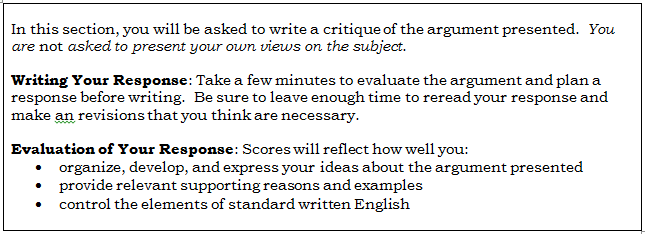
The first bullet point tells us: a good AWA essay is well-organized, has a natural flow from point to point, and is clear and unambiguous about what it is saying. Those are all important points to keep in mind.

The second bullet point reminds us: what they present will be, in all likelihood, a flawed argument, but what you must create is a cogent and clear argument, and that will necessarily involve providing clear and relevant support. It’s not enough simply to assert something badly: you must provide justification for what you are saying.
The final bullet points may appear enigmatic: “control the elements of standard written English.” What does that mean?
Well, first of all, it means no grammar or syntax mistakes . It also means varying the sentence structure —some simple sentences (noun + verb), some with two independent clauses (noun + verb + and/but/or + noun + verb), some with dependent clauses, some with infinitive phrases, some with participial phrases, etc. Finally, it means choosing the right words and the right tone : the tone should be skeptical toward the prompt argument and persuasive toward the points you are making, but not arrogant or dogmatic in any way.
The following paragraph always appears after the argument prompt. This is the real meat-and-potatoes of the AWA directions:

First of all, notice it give you one clear task: “Be sure to analyze the line of reasoning and the use of evidence in the argument.” Then, it lists several strategies that you might employ in your analysis. Don’t feel compelled to use every one of these in every AWA essay, though you should be using most of them in most essays.
If you’ve only taken standardized tests like the ACT or the SAT before, you may find AWA scoring slightly strange. GMAT Analytical Writing affects your overall score differently than essays on other exams do. With that in mind, let’s take a look at what a good GMAT analytical writing score on the GMAT is, as well as how important AWA test scores are to your overall GMAT score.
The GMAT Analytical Writing Scoring System
First, let’s get an important point out of the way: The AWA test score does not affect your overall GMAT score . Instead, it’s included as a separate category on your score report.
Although you won’t have an exact breakdown of your scores for each element, the GMAT analytical writing assessment is looking at your abilities in roughly four categories:
- Quality of Ideas
- Organization
- Writing Style
- Grammar and Usage
Based on your overall work, you’ll receive a score from 0 to 6, in half-point increments.
So just who decides where your essay falls within each of these four categories? First of all, a computer does. This is a bit surprising to most students when they first learn about it—after all, how can a computer evaluate something as subjective as writing? Well, remember that you’re not being scored on poetry here. Instead, the computer looks at the organization, syntax, and analytical aspects—things the GMAT algorithm is pretty good at doing.
Then, a trained evaluator will score the essay based on the general development of your ideas and written expression. The GMAT then averages these scores into your overall AWA score. Don’t worry about huge discrepancies in scores between the human and the computer graders, though: if the scores have more than a one-point difference, another human grader comes in to help set the final score.
GMAT AWA Percentiles
If you’re wondering, for example, how a GMAT analytical writing score of 4.5 compares to other test-takers’ scores, you’ll want to look at the GMAT AWA percentiles . GMAC regularly updates this information so that you can see what percentage of previous test-takers received each score.
How to Score Your Practice GMAT Essays
Scoring your own GMAT writing can be a little bit like trying to scratch your own back: it’s hard to see exactly where you are. But it can be done! By breaking down each component of your sample AWA essay, grading it, and averaging those grades, you can get some idea of your strengths and weaknesses. Magoosh even has a GMAT AWA scoring rubric you can use for this purpose.
How to Approach the GMAT AWA
Once you know what to expect from GMAT analytical writing, it’s time to start implementing strategies that will help you maximize your score on this section. Keep coming back to these throughout your GMAT prep to ensure that you’re staying on track and pushing your GMAT writing to the next level!
Strategies for the AWA
Here are the tips that will support your success on the GMAT’s AWA:
- Recognize Unstated Assumptions : Recognizing assumptions is essential for the Critical Reasoning questions, and it will also serve you well on attacking the prompt argument in your AWA.
- Know the Directions : This a matter not only of knowing what they say but also, more importantly, understanding the various options you have for analyzing the argument. This list of analytical strategies is always given in the paragraph that follows the prompt argument. It’s important to get familiar with this “analytical toolbox”, so it is yours to employ on test day.
- Recognize the Common Flaw Patterns : GMAT AWA prompt arguments often contain one of six types of flaws . Learn to spot these patterns, so you are ready on test day.
- Plan Before You Write : This is obvious to some test-takers. Your first task is to find objections to and flaws in the prompt argument. Create a list of flaws. Then, select the 2-4 of those that are most relevant, that would be the most persuasive talking points. Once you have your list of insightful flaws, then you are ready to write.
- Paragraph #1: State that the prompt argument is flawed. Briefly enumerate the flaws you will examine, in the order that you will discuss them.
- Paragraph #2 (or #2 & #3): Sticking to that same order, analyze each flaw in detail, explaining your reasoning why each is a serious weakness of the argument.
- Last Paragraph: Suggest improvements, which are the reverse of the flaws (i.e. “This argument would be considerably stronger if it did such-and-such to remove flaw #2.”). Close by restating that is it a weak argument.
- Simple sentence, one independent clause: Jack went to town .
- Sentence with two independent clauses: Jill went to town and Jack stayed home . (Two independent clauses can be joined by “and”, “or”, “but”, “yet”, “so”, etc.)
- Sentence with an independent clause and one (or more) dependent clauses: Jack went to the town where Jill lives .
- Sentence with an infinitive phrase: Jack went to that town to see Jill .
- Sentence with a participial phrase: Hoping to see Jack, Jill went to town .
A good essay should not have two sentences in a row with the same structure.
- Vague Language: The words “few”, “many”, “more”, “less”, and “some”, by themselves without numerical qualification, can be vague. Always consider the range of possibilities contained in vague words comparing quantity or size.
- Inappropriate Comparisons: This form presents a premise and conclusion for Thing #1, which is often quite clear and undisputable. Then, it argues, Thing #2 is very similar, so the premise and conclusion should apply to Thing #2 as well. Depending on the situation, the comparison may not be apt, and pointing out Thing #2 differs from Thing #1 in ways relevant to the argument can expose an essential flaw.
- Cause/Effect Errors: Many arguments want to make the case that “A causes B.” Whenever the argument “A causes B” is presented, some alternative interpretations to consider are (1) the reverse, “B causes A”; or (2) “A and B are both caused by new thing C”, or (3) “A and B, for a variety of reasons, often appear together, but one does not cause the other.” (This last interpretation is summed up succinctly in the sentence: “Correlation does not imply causality.”) Learn to spot arguments that draw conclusions of causality, and questions whether that’s the correct relationship.
- Overconfident Conclusions: Confidence = good. Overconfidence = bad. If you read the NY Times or the Wall Street Journal or the Economist magazine, you will notice the kind of tone the GMAT favors: thoughtful, balanced, and measured. Extreme conclusions are seldom correct on the GMAT. Any AWA prompt that presents a conclusion with God-given certainty is too strong, and this is a flaw that needs to be addressed.
- Proofread! Proofread! Proofread! : When you proofread, you have to consider several levels simultaneous: Is every word spelled correctly? Is every structure grammatically correct? Does the argument logically flow? Unfortunately (or fortunately!) you are not allowed to read your essay aloud in the testing center. What I do recommend, though: silently mouth the words, as if you are carefully pronouncing each word, even though you are not making any sounds. When you move your mouth & tongue, you are engaging more of your brain than when you are simply reading silently with your eyes, and you are more likely to catch subtle mistakes.
Those AWA test tips are all important to keep in mind for your GMAT writing. But when you actually sit down at the computer on test day, what should you do? Here’s the process to use to get the most out of your 30 minutes with the GMAT AWA, including a more in-depth GMAT writing template!
By the time you sit down on test day, you should have read the directions to the AWA (they’re posted above—take another look!), so you won’t need to waste time reading them again. Instead, dive straight into AWA brainstorming . As you brainstorm, list the argument’s flaws; then evaluate those flaws to find which objections are the strongest.
Write an Introduction
You don’t need to reinvent the wheel with each GMAT AWA introduction . Start by stating where the passage is from. Then, focus on two main tasks: summarizing the argument and stating why it’s flawed. Keep it short and sweet; three sentences are enough to get your main points set up!
Construct Your Body Paragraphs
These will make up the lion’s share of your essay, so you’ll spend most of your time writing body paragraphs. Here’s how to go about doing that:
- Identification: Focus on a Premise: The first thing you will need to do in your paragraph is to identify what part of the argument you intend to analyze. The best way to do this is by simply summarizing the premise in the argument. You can state that it is flawed at this point, but it is not necessary. You’ll have plenty of time to do that, and the reader already knows what will happen from what you told them in the introduction. Paraphrase, summarize, and use synonyms to present the premise—don’t copy word for word—and this is a great way to lay the groundwork for your analysis.
- State the Obvious: Flaws Hurt Arguments : This is a common step skipped in student essays. We must return to the larger picture. Students assume that everything will make sense once the flaw is exposed, but this is far too brash. We can’t just expect our reader to “get it.” We need to speak plainly and directly about how the flaw weakens the argument, and more specifically, the recommendation, plan, or conclusion of the argument. Not all flaws weaken arguments in the same way so be specific about what aspect of the conclusion is questionable.
- Do Good: Improve and Strengthen the Argument : Now that you’ve taken the time to analyze the argument, break down a flaw, and explain the result of that flaw to the conclusion, time to build it back up. Approach the essay as a concerned and interested party, responding to the argument with sympathy. Don’t just be destructive. Give suggestions for improvement. And if you don’t like the conclusion, peer into the heart of what it is trying to accomplish and recommend a way to get there.
Conclude the Essay
First of all, keep in mind that you should not dwell in the conclusion. The heart of your essay, what really matters toward your score, is in the body paragraphs. These should be bulky and in-depth, but the conclusion should be short and to the point. Wrap things up in a timely manner so that you can get to the business of editing and revising your essay.
To keep things manageable and short, don’t go into the details. You only need to recap the major problems in the argument. Sometimes it is enough to say that there are major problems in the argument. Ignore the desire to repeat all the main points that you covered in the body paragraphs. This will only take extra space and waste precious time.
Finally, recommend a way to achieve the goal stated in the article. It is important to approach the analysis of the argument as an interested party. You don’t want to be wholly negative. For one, you will write a better analysis if you imagine yourself tied to the argument in some way, and two, the prompt asks you to strengthen the argument. Find some general evidence that will make the argument more convincing or make it irrefutable. Suggest a change so that the logic stands on firmer ground.
A GMAT analytical writing sample essay, whether well done or flawed in itself, can help you polish your own GMAT writing and bring your essays to the next level. The important part of reviewing example GMAT essays is in analyzing them (and expert analysis is even more helpful, particularly at the beginning).
Where can you find sample GMAT analytical writing prompts? Easy! The GMAC (the GMAT test-maker) actually provides all possible AWA essay topics on their website. So if you need examples of analytical questions for the GMAT , look no further!
So just how important are the AWA scores for business school admissions? We certainly could argue that the GMAT Analytical Writing score is not so important. It’s undeniable that the Quantitative sections and Verbal sections, which contribute to the overall GMAT score, are considerably more important than the separate GMAT writing score . Arguably, the fact that the AWA section was “cut in half” when IR was added in 2012 is a further indication of the relative importance of the GMAT essay and its score.
It’s true that Business school adcoms rely on the Quant, Verbal and Composite scores significantly more than the GMAT writing score. In fact, recent evidence suggest that adcoms also rely on the IR score significantly more than the GMAT essay score.
But while it’s true that, in your GMAT preparation , Quant and Verbal and even IR deserve more attention than the AWA, it’s also true you can’t completely neglect AWA. The difference between a 5 or 6 as your GMAT Analytic Writing score will not make or break a business school admission decision, but having an essay score below a 4 could hurt you.
The purpose of the AWA is to see how well you write, how effectively you express yourself in written form. This is vital in the modern business world, where you may conduct extensive deals with folks you only know via email and online chatting. Some of your important contacts in your business career will know you primarily through your writing, and for some, your writing might be their first experience of you. You never get a second chance to make a first impression, and when this first impression is in written form, the professional importance of producing high-quality writing is clear.
While you don’t need to write like Herman Melville, you need to be competent. A GMAT Analytic Writing score below 4 may cause business schools to question your competence. That’s why it’s important to have at least a decent showing in AWA.
For Non-Native English Speakers
In particular, if English is not your native language, I realize that this makes the AWA essay all the more challenging, but of course, a solid performance on the AWA by a non-native speaker would be a powerful testament to how well that student has learned English . Toward this end, non-native speakers should practice writing the AWA essay and try to get high-quality feedback on their essays.
Devoting 30% or more of your available study time to AWA is likely unwise, but devoting 0% to AWA might also hurt you. Between those, erring on the low side would be appropriate. If, in a three-month span, you write half a dozen practice essays , and get generally positive feedback on them with respect to the GMAT standards, that should be plenty of preparation.
The GMAT analytical writing can feel like a slog when you first encounter it: it requires deep focus and analysis, and it’s not what most students have spent their prep time working on. But with a bit of preparation, your GMAT essays can take your admissions file to the next level by boosting your AWA test score significantly!
By including GMAT writing in your overall GMAT prep schedule, you’ll ensure that this section of the test doesn’t become a drag on your application—and helps, rather than hurts, your shot at your dream school. Good luck!

Rachel is one of Magoosh’s Content Creators. She writes and updates content on our High School and GRE Blogs to ensure students are equipped with the best information during their test prep journey. As a test-prep instructor for more than five years in there different countries, Rachel has helped students around the world prepare for various standardized tests, including the SAT, ACT, TOEFL, GRE, and GMAT, and she is one of the authors of our Magoosh ACT Prep Book . Rachel has a Bachelor of Arts in Comparative Literature from Brown University, an MA in Cinematography from the Université de Paris VII, and a Ph.D. in Film Studies from University College London. For over a decade, Rachel has honed her craft as a fiction and memoir writer and public speaker. Her novel, THE BALLERINAS , is forthcoming in December 2021 from St. Martin’s Press , while her memoir, GRADUATES IN WONDERLAND , co-written with Jessica Pan, was published in 2014 by Penguin Random House. Her work has appeared in over a dozen online and print publications, including Vanity Fair Hollywood. When she isn’t strategically stringing words together at Magoosh, you can find Rachel riding horses or with her nose in a book. Join her on Twitter , Instagram , or Facebook !
View all posts
More from Magoosh

Leave a Reply Cancel reply
Your email address will not be published. Required fields are marked *
GMAT AWA Writing Tips: 5 Steps for a 6.0 Score
Last Updated on May 12, 2023
GMAT test-takers tend to get a bit nervous about the Analytical Writing Assessment (AWA) because preparing for it doesn’t seem quite as straightforward as preparing for GMAT Quant or Verbal. Is it even possible to “study” how to write a high-scoring essay on an unknown topic with 30 minutes on the clock?
In truth, there is a formula to performing well on the GMAT Analytical Writing Assessment, and you don’t have to be Ralph Waldo Emerson to earn an enviable AWA score. In this article, I’ll give you 5 essential GMAT writing tips for scoring well on the Analytical Writing Assessment, including a 5-paragraph structure that will allow you to tackle any GMAT AWA question that gets thrown your way.
First things first, let’s review what exactly the GMAT Analytical Writing Assessment is and how it’s scored.
What Is the GMAT Analytical Writing Assessment?
How is the analytical writing assessment scored, how do i interpret my awa score, paragraph 1: intro, paragraphs 2-4: supporting points, paragraph 5: conclusion, tip #2: include transition words, tip #3: don’t neglect the basics, tip #4: don’t expect time to revise, tip #5: practice formulating supporting points.
The Analytical Writing Assessment (AWA) is a 30-minute section of the in-person GMAT that consists of one essay task, an “analysis of an argument.” Depending on what section order you choose for your exam, you’ll complete the AWA section either first or last when you sit for your GMAT. If you choose the default section order, the AWA section will appear first. If you choose to complete either the Quant or Verbal section first, the AWA section will appear last.
In AWA, an argument is presented to you that you must critique in an essay that can be any length. Your job is to analyze the argument’s reasoning, point out flaws and assumptions in the argument, and assess how evidence is used to support the argument’s conclusion, all while logically organizing and clearly communicating your ideas. AWA questions typically focus on business-related topics and are presented in the form of an excerpt from a hypothetical magazine or newspaper article, editorial, company memo or report, corporate or organization newsletter, or business plan, to name a few examples. The given argument in an AWA question is always accompanied by the following instructional statement:
“Discuss how well reasoned you find this argument. In your discussion be sure to analyze the line of reasoning and the use of evidence in the argument. For example, you may need to consider what questionable assumptions underlie the thinking and what alternative explanations or counterexamples might weaken the conclusion. You can also discuss what sort of evidence would strengthen or refute the argument, what changes in the argument would make it more logically sound, and what, if anything, would help you better evaluate its conclusion.”
Generally speaking, your AWA essay is evaluated on the basis of the overall strength of your analysis of the given argument, the relevancy of the points you make, how your essay is organized, and the effectiveness with which you communicate your ideas.
So, for example, an AWA question might present a short paragraph from a company memo. The paragraph explains the company’s reasoning behind a recent decision to change some aspect of the company’s operations. Your job is to find any flaws in the company’s reasoning, explain why they are flaws, and point out any further information that would be useful in assessing whether the company’s reasoning was valid. Fortunately, you are not required to give your personal views on the subject matter or have any specific knowledge of the given topic.
AWA questions do not require that you give your personal views on or have any specific knowledge of the given topic.
Now that we’ve reviewed the basics of what the GMAT AWA is, let’s take a look at how the section is scored.
The GMAT Analytical Writing Assessment is scored in half-point increments on a scale of 0 to 6. Your AWA score is not factored into your total GMAT score and is not included in the unofficial score report that you see on test day immediately after you finish your exam. The reason the AWA score is not included in your unofficial report is that, unlike the other sections of the GMAT, which are scored by the computer, the AWA is scored by both a computer and a human scorer. A trained human reader scores your essay using whole points from 0 to 6, and a computer algorithm scores your essay using half-point increments from 0 to 6.
Then, the two scores are averaged to produce your final score. If there is a large disparity between the human score and the computer score, a second human scorer evaluates your essay, and your score may be adjusted. Additionally, if you feel that your AWA score does not accurately reflect your essay, you can submit a request to have your essay rescored by an independent reader, for a fee of $45. Rescoring requests can be made only once per essay and must be submitted within 6 months of your test date.
Since the AWA takes longer to score than the other sections of the GMAT, you and any score recipients you select on test day will receive your AWA score when your Official Score Report is available, about two weeks after your test date. In the case of revised AWA scores, your new score will be sent to you and any designated schools about 20 days after you submit your rescore request.
Now let’s look at how to interpret AWA scores.
As with other GMAT section scores , every possible AWA score is associated with a percentile ranking. Here are the current percentile rankings, as compiled by GMAC:
These percentile rankings tell us, for example, that if you earn a perfect score of 6.0 on the AWA section, then you have scored better than 88% of all GMAT test-takers. According to GMAC, the mean AWA score was 4.45 for all test-takers who sat for the GMAT during the period from January 2017 through December 2019. As you can see in the table above, that mean is just below the 46th percentile. In general, schools consider a score of 4.5, or better than 46% of all test-takers, about average and consider a score of 5.0, or better than 56% of all test-takers, “good.” For most programs, your AWA score is likely to raise some eyebrows if it’s below 4.0.
Most schools generally consider an GMAT AWA score of 4.5 about average and a score of 5.0 “good.”
So, we know what the GMAT AWA section tests, how it’s scored, and what those scores mean. Now let’s take a look at the 5 essential GMAT AWA writing tips for earning a great score.
Tip #1: Use a 5-Paragraph Template
As I’ll discuss in further detail later, there are dozens and dozens of possible essay topics that can appear on the GMAT, and you have no way of knowing which topic will appear on your test. Thus, it is not a realistic or efficient strategy to try to game out answers to all of the possible essay prompts or memorize what the prompts are (a full list of the possible AWA questions is published by GMAC here ).
The great news is that you don’t need to know which argument you’ll be presented with on test day in order to write a well-organized response to it within the 30-minute time limit. Instead, you can apply a simple 5-paragraph structure to any GMAT essay topic in order to write a logically organized response containing the elements necessary to earn a high AWA score.
The standard 5-paragraph essay structure consists of the following:
- An introductory paragraph
- Three supporting points (paragraphs 2, 3, and 4)
- A conclusion (paragraph 5)
Although there is no required word count for a GMAT AWA essay, a wise strategy is to shoot for around 500 words , give or take.
No matter the topic or argument, the basic template above will provide you with a logical framework for organizing your essay.
Apply a simple 5-paragraph structure to any GMAT essay topic to write a logically organized and complete argument analysis.
Let’s take a look at each part of the 5-paragraph structure in greater detail.
The purpose of your introductory paragraph is to restate the argument that has been presented to you and state your intention for critiquing it. In stating your intention, you should mention the flaws in the argument that you plan to address. Essentially, this prepares the reader for the points that they will encounter in paragraphs 2 through 4, without providing the specific details that those later paragraphs will include. In fact, your intro paragraph should accomplish everything it needs to in around 5 or 6 sentences.
The purpose of your introductory paragraph is to restate the argument that has been presented to you and state your intention for critiquing it.
The first sentence of the intro paragraph should always restate the given argument. So, you might start off your essay in one of the following ways, for example:
The argument states that … The argument claims that … The argument makes the claim that …
No need to get creative with the jumping off point for your AWA essay; you simply want to show that you understand what the argument is. When restating the argument, you can repeat much of the same language that is used in the question stem, but you should aim to rephrase the argument in as concise a manner as possible. You want to encapsulate the crux of the argument, not just rewrite the entire essay prompt. In particular, if the argument provides supporting evidence, that evidence is not necessary to repeat in your restatement of the argument. You’ll address the given evidence later, in your supporting points.
To better understand how to restate an argument, let’s look at an example of an actual GMAT AWA example that a test-taker could see on the exam:
The following appeared as part of an annual report sent to stockholders by Olympic Foods, a processor of frozen foods:
“Over time, the costs of processing go down because as organizations learn how to do things better, they become more efficient. In color film processing, for example, the cost of a 3-by-5-inch print fell from 50 cents for five-day service in 1970 to 20 cents for one-day service in 1984. The same principle applies to the processing of food. And since Olympic Foods will soon celebrate its 25th birthday, we can expect that our long experience will enable us to minimize costs and thus maximize profits.”
So, your essay might start off with the following restatement of the given argument:
The argument claims that Olympic Foods’ nearly 25 years of experience in food processing will enable the company to minimize costs and thus maximize profits. This conclusion is based on the premise that the costs of processing go down over time because organizations become more efficient as they learn how to do things better.
As you can see, much of the exact same language used in the essay prompt is repeated in the restatement of the argument above. However, the information is reorganized somewhat; in this case, the premise and conclusion are in the reverse order, with the conclusion of the argument stated first, and the premise on which the conclusion is based stated afterward.
Furthermore, the perspective of how the argument is stated has changed. In the essay prompt, the perspective was that of a statement in an annual report sent to stockholders. Clearly, your essay response would not be written from such a perspective, so some changes to the wording of the prompt are necessary. Notice also that the somewhat conversational tone of the prompt has been eliminated in the restatement and that extraneous words are left out. Lastly, notice that the supporting example given in the prompt is not included in the restatement that begins our response.
Of course, how you restate a given argument will depend largely on what the argument is. In some cases, you may be able to restate an argument in one sentence. In other cases, as above, you may need two sentences. The goal is to clearly and succinctly state what the argument is, distilling it down to its essence using the language used in the prompt, but not including any of the “filler.” The good news is that no matter what AWA question you encounter, the first sentence or two of your response will essentially already be written for you!
Always begin a GMAT AWA with a restatement of the given argument.
Let’s continue with our Olympic Foods example above. Your next task in the intro paragraph, after you restate the argument, is to outline on what grounds you plan to attack the argument. For example, you might say that the argument fails to take several key factors into account in reaching its conclusion, and then list the 3 such factors that you will address in the paragraphs that follow. Or you might say that the argument makes faulty assumptions and bases its claims on insufficient evidence, and then mention what those assumptions are that you plan to critique. Again, your job here is to highlight only those weak points in the argument that you will critique in your supporting points, so you should not include any argument flaws in your intro that you won’t address later on. Quickly jotting down on your scratch pad which flaws you plan to address, before you start writing your essay, can help you organize your thoughts and pinpoint exactly what you want the focus of each supporting paragraph to be.
Remember, you may be able to find a dozen flaws in an argument, but you won’t have time to critique them all. Furthermore, you shouldn’t waste time finding more flaws than you need and trying to decide which are the “best” ones to write about. The flaws that are most obvious to you — in other words, the ones you notice first — are likely the ones that will be easiest for you to expound on. After all, you noticed them right away, so there are probably relatively clear reasons why they represent weak points in the argument.
So, your restatement of the argument should be followed by a brief summary or overview of what your response to the argument will be. Let’s take a look at how we might do that in the case of the Olympic Foods question:
However, the argument lacks relevant and sufficient evidence, making several assumptions that ignore key factors that could affect its conclusion. For example, the argument assumes that an organization becomes more efficient as time passes. Furthermore, the argument assumes that cost savings achieved in tandem with increased efficiency must be the result of increased efficiency. Finally, the argument assumes that the downward trend of costs that was observed in one sector of processing will replicate in another, unrelated sector of processing.
In total, our sample intro paragraph is 6 sentences: 2 sentences restating the argument, and 4 sentences laying out what our critique of the argument will be. Of course, your mileage may vary depending on the essay prompt, but this basic framework can apply to whatever GMAT AWA question you see.
In the intro paragraph, follow your restatement of the argument with a brief summary or overview of what your critique of the argument (supporting points) will be.
After you’ve introduced the points you’ll touch on in your AWA essay, you’ll need to expand on those points in the next 3 paragraphs. Let’s talk about that now.
Paragraphs 2 through 4 represent the “meat” of your essay, with each paragraph elaborating on one of the points of critique you summarized in your intro. At the beginning of each of these paragraphs, you’ll want to state what aspect of the argument you’re critiquing in that paragraph, and then why that aspect is flawed. You may want to use real-world examples to support your critique, particularly if the word count of your essay is a little light. At the end of each supporting paragraph, you may want to mention a way that the aspect of the argument you’re discussing could’ve been strengthened.
Let’s take for example the second flaw that we set out to critique in our Olympic Foods essay, which will be the focus of the essay’s third paragraph: the argument assumes that cost savings achieved in tandem with increased efficiency must be the result of increased efficiency. In this paragraph, you might start off by saying that the argument supports its conclusion with an example of a decrease in cost and coinciding increase in processing speed that was realized after a number of years. You might then go on to say that the argument provides no evidence to demonstrate that this correlation is actually a causal relationship. Then, you might provide the real-world example of increased automation over those years as a factor that could simultaneously cut the labor costs associated with processing (and therefore reduce the total processing cost) and increase processing speed. Of course, automation and other technological advancements may or may not be readily available at any point in time and can be implemented at an organization regardless of how long it has been in existence, and both of those facts undermine the argument’s conclusion that Olympic Foods can expect to minimize costs because of its long experience. Thus, the argument would have been more convincing if it presented evidence that established that the observed cost savings were actually the result of faster processing times as opposed to some other factor, such as increased automation.
Each of the 3 paragraphs between your intro and your conclusion should elaborate on 1 of the supporting points you summarized in your intro.
Before we move on to the conclusion paragraph, I want to address a common question among GMAT students: whether writing 2 supporting paragraphs instead of 3 is a score-killer in AWA. The truth is, you may be able to earn a decent AWA score by including just 2 supporting points in your essay. And if for some reason you are running seriously low on time or absolutely can’t come up with a third supporting point, then I would say that a completed essay with just 2 supporting points is certainly better than an essay with 2 and a half supporting points and no conclusion, or 3 supporting points and no conclusion. However, there is really no way to say for sure what exact score difference 2 vs. 3 supporting paragraphs makes. So, to be on the safe side — unless you are truly stumped for ideas — plan to write 3.
Your conclusion paragraph is similar to your intro paragraph in that it should summarize the ways that the given argument is flawed. However, your conclusion should also summarize how the argument could be strengthened or the argument’s conclusion could be more accurately assessed. So, essentially, your conclusion paragraph pulls from all of the paragraphs that came before it, providing a tight summary of the main points of your critique and “wrapping a bow” around what you have stated about the validity of the argument’s reasoning.
A conclusion paragraph often begins with a phrase such as “In conclusion,” or “In summary,” but depending on how you organize your thoughts, you may choose to begin your conclusion paragraph differently. Additionally, you may decide to include a “concession” as part of your conclusion. A concession is a statement recognizing that some aspect of a given argument may be valid. For example, a concession could be phrased as such:
Although the argument rightly acknowledges that increased efficiency is one way that an organization can achieve cost savings …
Similar to the intro paragraph, the conclusion paragraph should accomplish its aims in around 4 or 5 sentences. This is not the place to reiterate details, give examples, or introduce new information.
In about 4 or 5 sentences, your conclusion paragraph should provide a tight summary of the main points of your critique and “wrap a bow” around what you have stated about the validity of the argument’s reasoning.
Before we move on to tip #2, take a look at the GMAT analytical writing example question, along with an essay response that received the highest possible AWA score, 6.0, at the bottom of this page . Notice that the essay follows the basic structure of introduction, 3 supporting points with real-world examples, and conclusion. In this case, the writer broke the introductory paragraph into two paragraphs, with the first paragraph restating the argument, and the second paragraph summarizing the intended response, but you can see that the component parts of the essay remain the same as those in our standard 5-paragraph structure.
An important part of scoring well on GMAT Analytical Writing is demonstrating logical organization and clear communication of your thoughts from sentence to sentence and paragraph to paragraph. If your essay seems to jump randomly from one idea to the next, then the reader scoring your essay will have a harder time following your train of thought. Thus, your analysis of the given argument may seem confusing and poorly thought out.
The fact is, even if your ideas are laid out in a logical order, in order to make your essay more readable and understandable, you need to create smooth transitions between paragraphs and between different ideas within the same paragraph. One of the main ways to create smooth transitions is to introduce new ideas using transition words and phrases. For example, the phrase “for example” is a transition phrase that we can use any time we want to shift from talking about a concept to talking about an example that illustrates that concept. Such words and phrases form the “connective tissue” that brings together all of the different parts of an essay into a cohesive whole.
Transition words and phrases form the “connective tissue” that brings together all of the different parts of an essay into a cohesive whole.
Transition words are commonly used to introduce new paragraphs, but you should also seek to incorporate them within the paragraphs of your essay in order to introduce examples or opinions, indicate contrast or support, help sum up your thoughts, show a result, or add emphasis to an important idea. Here are some key transition words and phrases that often come in handy in writing GMAT AWA essays:
- For example
- For instance
- Additionally
- In addition
- Furthermore
- In contrast
- On the other hand
- As a result
- Consequently
- In conclusion
The point is not to memorize this list but to be aware of the importance of transition words for clarifying your ideas and showing the logical progression of your analysis. In short, transition words make your essay more readable! Remember, there will eventually be a person reading and scoring your essay, a person who likely has to evaluate many, many GMAT essays. So, you want to make your essay as clear and engaging as possible. Transition words can help you do just that.
Use transition words throughout your essay to introduce new paragraphs, link different ideas within paragraphs, and show the logical progression of your thoughts.
Although the AWA section is primarily scored with an eye toward the overall structure, cohesiveness, and clarity of your essay, technical aspects such as grammar, spelling, and word choice are still factored into your AWA score. In this respect, the knowledge you’ve gathered while training for GMAT Sentence Correction should come in handy. Are your sentences well-structured, clear, and concise, or are they wordy and circular? Does your essay contain any run-on sentences, redundant words, or incorrect idioms? While you shouldn’t expect to have time to make sure that your essay is grammatically perfect, you do want to make sure that you don’t turn in sloppy, rushed writing.
Keep in mind that a few errors here and there are not going to sink your AWA score, but your essay will appear more polished and “finished” if you’re mindful of basic grammar rules and spelling. If a sentence is becoming overly long and winding, break it into two sentences. Demonstrate a broad vocabulary by varying your word choice. Most importantly, be aware that, even if your analysis is sound and your essay is well-organized, if you completely neglect the basics of grammar and spelling, your ideas will be less clear and your essay will be less readable overall.
Vary your word choice, break up overly long sentences, and be mindful of basic grammar and spelling in order to create a more polished essay.
You may be surprised at how quickly the time flies by when you’re writing your essay. So, don’t expect that you’ll have time at the end of the section to do significant revisions of what you wrote. In fact, you’re likely to find that you have no more than a minute or two — if that — to do a quick read-through of your completed essay. So, it’s important to construct your essay carefully and methodically as you’re writing it , because you probably won’t have time to go back later and do a major cleanup of your work or flesh out a bunch of half-formed ideas.
As you’re writing, make each sentence a “finished product” before you move onto the next one. Does that mean writing and rewriting the same sentence four times until you think it’s perfect? No. You will never be able to write a full and complete essay in the allotted time if you’re agonizing over every sentence. You don’t have time to seek perfection, nor do you need to in order to earn a great AWA score. If possible, use the last 2 minutes or so of your time to do a quick check for any spelling errors or glaring grammatical mistakes in your essay. Just don’t expect to have the last 10 or even 5 minutes of the section time to revise your work.
If possible, use the last 2 minutes of your time to do a quick check for spelling and grammar errors, but don’t expect to have 5 or 10 minutes to make significant revisions to your essay.
One of the most challenging and time-consuming aspects of the GMAT Analytical Writing Assessment is coming up with 3 supporting points. Your supporting points make up the bulk of your essay, and also the portion of your essay that requires the most critical thinking, creativity, and original thought. A great way to prepare yourself for this challenge is to practice thinking up supporting points for the actual essay topics published by GMAC. As a side benefit, this method of practice will also give you a chance to get acquainted with what AWA questions look like, the types of arguments they present, and how those arguments may be flawed.
Browse the topics list and choose a few at random for which you can practice coming up with 3 supporting points with real-world examples. You could also do a full practice essay or two, but I don’t recommend preparing for AWA by writing numerous, complete practice essays. The fact is, if you have the 5-paragraph template down, and you’ve reviewed the types of arguments presented in AWA questions, writing many practice essays really isn’t necessary in order to prepare for GMAT AWA. There is plenty to learn and practice for the GMAT , so you don’t want to waste valuable study time doing more than is actually needed to earn a high score. Thus, I also don’t recommend reading through the entire AWA question list (or attempting to memorize the essay prompts) as a productive use of your time.
Choose random essay prompts from the AWA question list published by GMAC, and practice coming up with 3 supporting points and real-world examples for them.
Now that you know these 5 key GMAT writing tips for scoring 6.0 on the Analytical Writing Assessment, check out these 8 tips for conquering GMAT Sentence Correction and these 8 GMAT Reading Comprehension dos and don’ts .
You May Also Like...
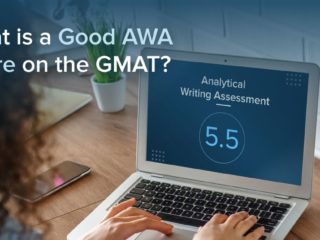
About The Author
Scott Woodbury-Stewart is the founder & CEO of Target Test Prep. A passionate teacher who is deeply invested in the success of his students, Scott began his career teaching physics, chemistry, math, and biology. Since then, he has spent more than a decade helping students gain entry into the world’s top business schools, logging 10,000+ hours of GMAT, EA, GRE and SAT instruction. Scott also served as lead content developer and curriculum architect for the revolutionary courses Target Test Prep GMAT, Target Test Prep EA, Target Test Prep GRE and Target Test Prep SAT Quant.
Leave a Reply Cancel Reply
Save my name, email, and website in this browser for the next time I comment.

- Skip to main content
- Skip to primary sidebar
Additional menu

GMAT Jumpstart
A Simple Breakdown of GMAT Format and Test Structure
posted on March 16, 2021
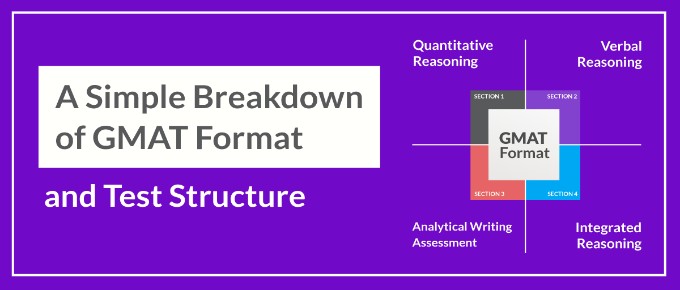
Understanding the GMAT format and test structure will help give you the strategy you need to excel on the exam. If your goal is to attend a Masters of Business Administration program, this will be essential.
While working through a GMAT study program, you’ll quickly realize that success relies as much on test-taking skills as it does on subject matter mastery.
This article is designed to help you understand the GMAT sections and exam format. Read on to learn what each GMAT section will entail, and how to craft a GMAT study plan that helps you tackle all of the challenges you’ll face.
GMAT Format
The GMAT is an electronic test taken on a computer. There are two ways to take the GMAT:
- At a GMAT Test Center , where you will schedule a three-and-a-half hour appointment and get two optional breaks during the test.
- With the GMAT Online Exam , where you will use your own computer system (as long as it meets system requirements) to take the test from home or at a remote location.
Whether you choose to take the GMAT in a test center or online, it will contain four sections:
- Quantitative Reasoning, which will measure your math and reasoning skills.
- Verbal Reasoning, which will test your ability to comprehend and correct reading passages.
- Analytical Writing Assessment, in which you will have to write an essay to proficiently communicate important ideas.
- Integrated Reasoning, which will test your ability to analyze data when it is presented in different ways and draw accurate conclusions.
GMAT Format and Structure Table
Here is a table showing how the questions of each GMAT section are structured, what each section is worth, and how long each section takes:
GMAT scores are calculated in a range from 200 to 800. Verbal and Quantitative are objectively scored by points based on your answers of multiple choice questions. Integrated Reasoning and Analytical Writing have some degree of subjectivity, with the latter being scored in part by hand.
While all of the GMAT test scores are considered to be reliable, it is possible to request an Essay Rescore if you think your AWA final score is inaccurate.
GMAT Exam Pattern Order
When you sit down at a computer to take the GMAT, you are able to choose the order in which you take each section. Over the course of three-and-a-half hours of test-taking, it is easy to get fatigued.
You know your own brain (and experience) best.
So, as you take GMAT practice tests , you’ll start formulating a strategy for the GMAT exam pattern order that works best for you.
Here are the three ways to order the GMAT:
- Analytical Writing, Integrated Reasoning, Quant, Verbal
- Quant, Verbal, Integrated Reasoning, Analytical Writing
- Verbal, Quant, Integrated Reasoning, Analytical Writing
Once you choose the order, that’s how the GMAT parts will show up on your computer test.
Computer Adaptive Test
Two sections of the GMAT are computer adaptive. Therefore, the test content you receive is tailored to the skill level you’re exhibiting. The two sections are Quant and Verbal Reasoning. Here’s an example of how the computer adaptive GMAT works:
When you start Verbal, you will get an answer that is about a medium level of difficulty.
- If you answer correctly: you’ll get a harder question next time.
- If you answer incorrectly: you’ll get an easier question next time.
There are two key takeaways about this:
- Because of the adaptive nature of the test, you cannot “go back” to previous questions or skip questions to answer later. Your answers literally determine what content you get. Once you’ve passed a question, you’re unable to revisit it.
- Some people think that the computer adaptive GMAT provides more accurate scoring and an assessment of a test-taker’s unique abilities or understanding.
So, from a test-taking perspective, the fact that the GMAT is adaptive shouldn’t spook you. Each question matters, so you should take them as they come.
GMAT Test Structure
Now let’s dive deeper into the actual GMAT test format for each section. Each section not only covers distinct subjects, but presents those subjects in different ways.
So, what does the GMAT consist of? Here’s a GMAT breakdown of what each section will entail.
Quantitative Section
Quant is an adaptive section, which means, as detailed previously, it will progress from medium to easier or more difficult content, depending on your answers. Here are the subjects covered in Quant:
- Decimals, percentages, fractions
- Profit and loss
- Number properties
- Powers and roots
- Probability
- Algebraic expressions and equations
That list is not exhaustive. Because of how dense this part is, many people invest in additional curriculum or textbooks to master the Quant section .
Quant has 31 questions and will take 62 minutes to complete. It’s important to note that, although you’re going to be doing a lot of math, you do not get a calculator for Quant.
Verbal Section
Verbal is the second computer adaptive section. There are three question types in Verbal, all of which you will practice for. They are:
- Sentence correction
- Critical reasoning
- Reading comprehension
The goal of Verbal is to test your ability to read, understand, and provide meaningful commentary on sections of written text. It may sound pretty straightforward, but it’s definitely going to take some practice.
Verbal has 36 questions and will take 65 minutes to complete.
- Integrated Reasoning
Integrated Reasoning is about problem solving. There are four types of questions you will encounter in this section of the GMAT. Each of them are set up with three subsections of multiple choice questions. They will include content in the four following areas:
- Table analysis: You will be given a data table (such as a spreadsheet) and have to sort, analyze, and assess what you see.
- Multi-source reasoning : This will present tables, graphics, and/or text passages. It will require you to answer questions that find errors/contradictions, draw inferences, and determine relevance, for example.
- Graphics interpretation : You may see plots, x/y graphs, pie charts, bar charts, and more. Then, you will have to find relationships in the data.
- Two part analysis : These complex problems may resemble what you see in Verbal or Quant. You will have to measure, evaluate, solve, and find connections.
Integrated Reasoning will have four question types and 12 questions in total. The good news is that you do get to use a calculator for this portion of the test, so it takes 30 minutes to complete.
- Analytical Writing Assessment
The Analytical Writing Assessment section of the GMAT is, as mentioned before, partially graded by humans. It’s important that you display competence in reflection, presenting proof, working out the logic of an argument, and drawing meaningful conclusions.
You will be given a writing task that is, essentially, an analysis of an argument. It will be important to identify and follow lines of reasoning, present evidence, and provide a cogent response. How articulate you are certainly matters in this section and it is something you should practice many times during your GMAT test prep .
Here are some answers to frequently asked questions about the GMAT format.
How Many Questions Are on the GMAT?
The GMAT has four sections with varying numbers of questions per part. They go as follows:
- Analytical Writing Assessment: 1 question
- Integrated Reasoning: 12 questions
- Quantitative Reasoning: 31 questions
- Verbal Reasoning: 36 questions
So, in total, you will be answering 80 questions in various formats across the four sections.
What is the New GMAT Format?
The GMAT is a computer adaptive test so it can be taken online or in a test center. All GMATs are taken on computers and are three-and-a-half hours long.
What Kind of Questions Are on the GMAT?
On the GMAT, you will encounter multiple choice questions and one essay question. For example, in the Verbal and Quant sections, these multiple choice questions are straightforward and discrete. But for Integrated Reasoning, there will be four large questions with subsections of three questions each. The Analytical Writing Assessment is a single essay question.
How Many Sections Are on the GMAT?
There are four sections on the GMAT. These are:
- Verbal Reasoning
- Quantitative Reasoning
In other words, you will need to work through arguments, solve problems, provide thoughtful analysis, and exhibit skills in math and language.
How Many Verbal Questions on GMAT?
The Verbal section of the GMAT has 36 questions.
How Many Quant Questions on GMAT?
The Quant section of the GMAT has 31 questions.

MBA Resources
Mastering the GMAT: Your Ultimate Guide to Success in 2024

MBA & Beyond Team
08/01/2024 | 3:11 pm
A. Brief Overview of the GMAT
The GMAT, known as the Graduate Management Admission Test, plays a crucial role in the admissions process of graduate business schools. Serving as a standardized assessment, the GMAT assesses the skills and readiness of individuals entering the challenging field of business education. It acts as a gatekeeper, providing a common metric to evaluate candidates on a level playing field. By offering a standardized evaluation, the GMAT allows admissions committees to compare applicants objectively, ensuring fairness and equity in the admissions process.

B. Importance of GMAT in the MBA Admissions Process
The GMAT holds great importance in the MBA admissions process as it serves as a crucial assessment tool. This standardized test evaluates candidates’ quantitative, verbal, analytical, and writing skills, providing business schools with a common benchmark to gauge academic potential. By measuring aptitude and critical thinking abilities, the GMAT offers insight into an applicant’s readiness for the rigorous curriculum of an MBA program. Admissions committees rely on the GMAT to assess candidates’ ability to excel in areas relevant to the business field. This comprehensive assessment of skills and abilities makes the GMAT an influential factor in the selection process for MBA programs.
C. Significance of Staying Updated on GMAT Trends in 2024
Staying updated on GMAT trends is crucial for effective test preparation in 2024. By understanding the current trends, test takers can tailor their strategies and focus on the areas that are most likely to be emphasized in the exam. These trends can include changes in question types, format, or content areas that receive greater emphasis. Being aware of such trends allows test takers to allocate their study time and resources effectively, ensuring they are well-prepared for the specific challenges they may face. Additionally, staying updated on trends allows individuals to access the most relevant study materials and resources that align with the current GMAT requirements. As the test evolves, being aware of the latest trends helps test takers stay ahead of the curve and enhances their chances of achieving their desired GMAT score. Therefore, it is essential to actively seek out and engage with the latest GMAT trends to optimize test preparation efforts in 2024.
II. Understanding the GMAT Format
A. overview of the gmat structure.
The GMAT is a complex examination, designed meticulously to assess a wide range of skills. Let’s break down the structure to gain insight into each section:
- Analytical Writing Assessment (AWA): This segment examines the candidate’s ability to effectively analyze and evaluate arguments.
- Integrated Reasoning (IR): It tests the candidate’s ability to interpret and synthesize data from various sources, requiring a comprehensive understanding.
- Quantitative Reasoning (QR): This section focuses on the candidate’s proficiency in solving quantitative problems accurately, using mathematical concepts.
- Verbal Reasoning (VR): It’s a holistic assessment that includes reading comprehension, critical reasoning, and sentence correction, evaluating the candidate’s linguistic and analytical abilities.
B. Changes and Updates in the GMAT Format for 2024
The temporal dimensions of the GMAT could potentially change in 2024. Being aware of the updated exam duration is essential for candidates to refine their test-taking strategies according to the revised time limits. It is important to understand the sectional breakdown and the weightage given to each section. This knowledge empowers candidates to manage their time effectively and approach all segments in a balanced manner. The adaptive nature of the test adds complexity, as the difficulty of subsequent questions depends on the candidate’s performance in preceding ones. Being prepared for this adaptive feature is a crucial aspect of a comprehensive GMAT strategy.
III. GMAT Calendar and Important Dates
A. gmat registration deadlines.
Starting your GMAT journey requires strategic planning, particularly when it comes to early registration. The registration deadlines vary depending on the format of the GMAT you choose:
- Classic GMAT: You have until January 31, 2024, to register for the traditional GMAT.
- GMAT Focus Edition : Registration for the new GMAT Focus Edition is currently open.
To know more about MBA exam deadlines and updates, click here
The Graduate Management Admission Council (GMAC) suggests signing up 2-3 months prior to your desired test date. However, if necessary, you can register online or by phone up to 24 hours before the exam. It is crucial to register early since popular test centers tend to fill up quickly. By doing so, you can secure your preferred location and date, allowing ample time for preparation without unnecessary stress.
B. Test Date Selection Strategies
Strategically choosing the test date is of utmost importance. Test takers should consider personal commitments, identify their peak performance times, and allocate enough time for thorough preparation. Thoughtful test date selection can have a significant impact on overall performance in the exam.
C. Importance of Planning Ahead
A robust study plan is crucial for GMAT success. It includes a detailed schedule, resources, and allocated study time. Planning ahead ensures comprehensive content coverage. A well-structured plan helps with organization, time management, and progress tracking. With a clear plan, productivity increases and preparation stress decreases. A strong study plan is key to a successful GMAT journey.
D. Managing Retake Schedules
Understanding when and why to consider retaking the GMAT is crucial for strategic planning. By analyzing the initial test results, candidates can pinpoint specific areas for improvement and adopt a targeted approach to retake preparation.
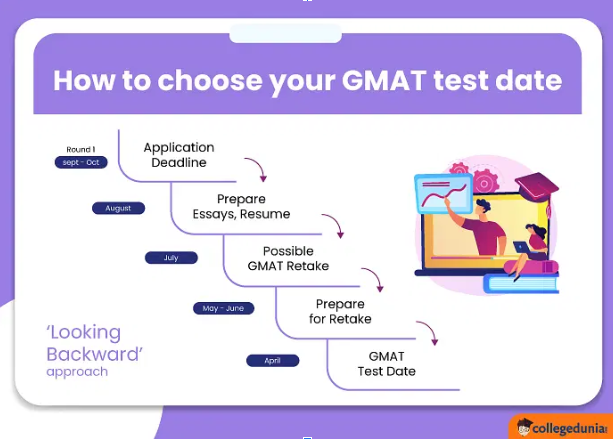
E. Importance of Planning Ahead
Planning ahead is crucial for effective GMAT preparation and plays a vital role in a candidate’s journey to success. This strategic process encompasses several essential elements:
- Creating a Study Plan: Crafting a well-structured study plan is crucial when it comes to creating a study plan. It provides a systematic and organized approach to covering the extensive GMAT syllabus. By thoughtfully allocating time, one can ensure comprehensive coverage of all relevant topics without overwhelming themselves.
- Gathering Resources: The selection of appropriate study materials is of utmost importance when gathering resources for studying. This includes making a wise choice of books, online resources, and practice tests. Accessing high-quality materials significantly contributes to the effectiveness of the preparation process.
- Setting Realistic Goals: Setting clear and realistic goals is not just a mere formality but a guiding principle in the study plan. Such goals serve as a roadmap for focused preparation, keeping the candidate engaged and motivated throughout the process. Additionally, they provide a tangible endpoint to strive towards.
F. Managing Retake Schedules
Understanding when and why to retake the GMAT is a strategic consideration. Analyzing the results of the initial attempt serves as a diagnostic tool, allowing candidates to:
Devise a targeted approach for improving : By identifying areas of weakness, candidates can tailor their preparation strategies. This focused approach ensures that efforts are concentrated on enhancing specific skills that may have contributed to challenges during the first attempt.
Catapult your MBA dreams into reality! Explore our YouTube video: ‘ Master the GMAT – Boost Scores & Secure Your MBA Spot! ‘ for essential insights and success strategies.
G. Free Mock Paper Links and Crash Courses for GMAT Prep
When commencing your GMAT preparation journey, having access to complementary practice papers and intensive courses can greatly heighten your level of readiness for the exam. Here are a few recommended resources that you should consider:
- E GMAT: E GMAT offers comprehensive GMAT preparation courses that encompass adaptive learning modules and customized study plans. Make sure to visit their website to avail yourself of their free trial access and available resources.
- Magoosh: Magoosh provides a user-friendly platform that offers a diverse range of GMAT prep resources. Take the opportunity to explore their blog, practice questions, and free trial options in order to strengthen your preparation.
Recommended Free Mock Paper Links:
- GMAT Club : A platform driven by the community that offers a wide variety of realistic GMAT practice tests and engaging discussion forums for free.
- Veritas Prep : Access realistic and engaging GMAT practice exams and resources to enhance your skills and evaluate your progress.
- Manhattan Prep : Manhattan Prep offers engaging and realistic GMAT resources, such as practice exams and valuable insights into various GMAT sections.
Additionally, consider exploring crash courses from reputable providers like Kaplan, Princeton Review, and Manhattan Prep. These courses often condense important concepts, offering a concentrated yet efficient study experience.
Remember, incorporating a variety of resources into your preparation plan will provide you with a well-rounded understanding of the GMAT format and help you pinpoint areas for improvement. Always take advantage of free trials and sample materials to ensure that the chosen resources align with your learning preferences.
IV. Setting Your GMAT Goals
A. importance of goal setting.
Setting clear and realistic goals is not only a preliminary step but an ongoing process in the GMAT preparation journey. These goals act as a dynamic roadmap, providing a simplified and engaging way to guide your preparation.
A Simplified Roadmap for Engaging Preparation: Setting clear goals allows for focused preparation by breaking down the extensive syllabus into manageable milestones. This organized approach prevents overwhelm and ensures consistent progress.
Alignment with Aspirations: Goals should correspond to the candidate’s aspirations, establishing a personalized connection to the journey. Aligning aspirations improves motivation and commitment to the preparation process.
Aligning goals with the requirements of target MBA programs ensures that the candidate’s efforts directly contribute to the competitiveness of their application. This reflects a thoughtful and strategic approach to the admission process, making it simpler and more engaging.
B. Assessing Your Target MBA Programs
Understanding the specific expectations and criteria of the MBA programs a candidate aims for involves tailoring their preparation accordingly. Gaining insights into the program expectations allows candidates to customize their preparation process, ensuring alignment with the unique characteristics and values of the targeted institutions.
C. Aligning GMAT Scores with MBA Program Requirements
The GMAT score is crucial for MBA admissions. It ensures applicants have necessary skills. Aligning GMAT scores with program requirements helps identify suitable candidates. Programs set a minimum score as a benchmark for readiness. Some programs may have different requirements based on background and competitiveness. Researching and understanding score expectations is essential for admission.
D. Personalized Tips
Tailor your GMAT preparation to suit your specific needs by first setting realistic and engaging goals. Consider the specific requirements of your desired MBA programs in order to ensure a smooth timeline. Schedule your GMAT exam at least 2 months in advance of your planned test date to allow for ample preparation time. Incorporate regular mock exams into your routine, aiming for a weekly or bi-weekly schedule, to enhance your readiness. This proactive approach will not only help you assess your progress but also build the stamina and confidence required for success on the actual GMAT.
V. Creating a Study Plan
A. establishing a realistic timeline.
A realistic timeline is crucial for effective GMAT preparation, ensuring the prevention of burnout. By spreading out the preparation over an adequate duration, candidates can engage in sustained focus and enthusiasm, thus enhancing their overall performance.
B. Identifying Strengths and Weaknesses
Analyzing strengths and weaknesses is crucial for personal and business development. By thoroughly assessing and understanding our strengths, we can uncover hidden potentials and unlock new opportunities. Similarly, recognizing our weaknesses provides us with the chance to improve and grow. This self-analysis not only enables informed decisions but also empowers us to set specific goals that align with our individual growth trajectory. Taking the time to evaluate our strengths and weaknesses is an invaluable investment in our personal and professional journey towards success.
C. Choosing the Right Study Materials
When choosing study materials, evaluate credibility and reputation of sources like publishers, institutions, or professionals. Assess content relevance, organization, and structure. Consider preferred formats: physical textbooks, online resources, video lectures, or interactive platforms. Review feedback from others who have used materials. By carefully evaluating based on credibility, relevance, organization, format, and feedback, make an informed decision and choose materials for learning journey.
Maximize your success for the September 2023 MBA intake! Explore effective planning for R1 applications and GMAT study insights in this video.
VI. Utilizing Technology for GMAT Prep
A. adaptive learning platforms.
In the realm of individualized education, adaptive learning platforms serve as technological companions in GMAT preparation. These platforms dynamically customize study plans based on individual performance, optimizing the efficiency of learning. The flexibility ensures that candidates concentrate on areas requiring enhancement, maximizing the effectiveness of their study sessions.
B. Mobile Apps for On-the-Go Study
Embracing the true essence of flexibility, mobile applications surface as indispensable tools for GMAT preparation on the move. Ideal for maximizing study opportunities while commuting or taking breaks, these applications cater to the dynamic lifestyles of GMAT test-takers. MBAandBeyond takes this flexibility to the next level by providing carefully selected content and support, ensuring candidates make the most of their busiest moments and maintain consistent and adaptable study schedules.
C. Virtual Tutoring and Study Groups
Breaking the barriers of traditional education, virtual tutoring and study groups bring a sense of community to GMAT preparation. Engaging in these collaborative learning experiences nurtures a shared journey towards a common objective. The exchange of ideas, perspectives, and support within these virtual platforms not only deepens comprehension but also enhances motivation. Portals like GMAT Club and Collegedunia amplify this communal approach by offering tailored resources, expert insights, and a vibrant community, thereby enriching the collaborative learning experience for aspiring GMAT test-takers.
VII. Mastering GMAT Quantitative Skills
A. reviewing fundamental math concepts.
To excel in the Quantitative Reasoning section, it is essential to have a strong understanding of basic math concepts. Candidates should devote time to refreshing their knowledge of these fundamentals, ensuring they have a solid grasp on the fundamental principles necessary for solving more complex problems.
B. Strategies for Tackling Data Sufficiency Questions
Data Sufficiency questions present a unique and engaging challenge. It is crucial to master strategies specific to this question type. Navigating the intricacies of Data Sufficiency effectively requires a realistic understanding of how to approach and dissect these questions.

C. Tips for Improving Problem-Solving Speed
Enhancing problem-solving speed is a multifaceted and engaging goal that requires a realistic approach. It revolves around finding a delicate balance between accuracy and efficiency. Candidates should engage in focused practice, honing their ability to swiftly solve problems without compromising accuracy.
D. Utilizing Technology for Quantitative Practice
Technology becomes a valuable ally in the pursuit of mastering quantitative skills. Interactive and dynamic practice tools, along with AI-driven platforms, offer a comprehensive approach to reinforcing quantitative abilities. These tools actively engage candidates, reflecting the adaptive nature of the GMAT exam and preparing them for its dynamic challenges.
Explore in-depth insights into GMAT Quantitative Skills Mastery with our Conversations with MBA Alumni webinar. Watch the full recording on our YouTube channel.
VIII. Excelling in GMAT Verbal Skills
A. strengthening reading comprehension abilities.
Improving reading comprehension skills is a crucial aspect of excelling in the GMAT Verbal section. This can be accomplished by:
- Focused Practice: Engaging in targeted practice exercises that concentrate on reading comprehension helps to refine the ability to extract essential information and comprehend intricate passages.
- Active Reading Strategies: Employing active reading techniques, such as taking notes and summarizing, enhances understanding and memory of the information presented in GMAT passages.
B. Effective Strategies for Sentence Correction
Developing mastery in sentence correction requires a comprehensive approach, which includes:
- Understanding Grammar Rules: A strong foundation in grammar rules is essential. Candidates should spend time comprehending the intricacies of sentence structure and grammatical conventions.
- Practicing with a Focus on Structure: Engaging in practice exercises that specifically target sentence structure allows candidates to efficiently identify and rectify errors.
C. Analyzing Critical Reasoning Questions
Critical reasoning questions require analytical thinking, and effective analysis strategies include:
- Developing analytical thinking skills: It is crucial for candidates to practice dissecting arguments, identifying premises, conclusions, and logical fallacies.
- Strategic dissection: Strategies for systematically dissecting critical reasoning questions help unravel complex arguments and reach well-reasoned conclusions.
D. Leveraging Technology for Verbal Practice
The usage of technology allows individuals to engage in simplified and more engaging verbal practice. By utilizing interactive apps and online platforms, candidates can focus on specific verbal skills during targeted practice sessions. Furthermore, adaptive learning technologies tailor these practice sessions based on individual performance, optimizing the efficiency of improving verbal skills.
IX. Enhancing Analytical Writing and Integrated Reasoning
A. understanding the awa section, essay structure and content.
Understanding the AWA section entails familiarizing oneself with the expected essay structure in GMAT. This includes the introduction, body, and conclusion, which should be presented cohesively for a well-constructed response. Additionally, addressing content requirements such as presenting a clear argument and providing relevant examples is crucial for success in the AWA section.
Enhance your MBA application by receiving expert guidance! Uncover the 6 most valuable tips for creating a captivating MBA essay in our exclusive webinar presented by MBA & Beyond. Take advantage of the opportunity to view the full video on our YouTube channel:
Avoiding Common Pitfalls
Identifying and avoiding common pitfalls can greatly improve candidates’ performance by helping them steer clear of mistakes. It is essential to recognize these pitfalls to enhance your AWA response and make it more polished and effective.
X. Test-Taking Strategies and Time Management
A. simulating test conditions during practice.
Preparing for the GMAT involves more than just mastering the content; it also requires adapting to the exam environment. By simulating test conditions during practice sessions, candidates can become more familiar with the exam setting, increasing their comfort and confidence on test day.
B. Developing an Efficient Time Management Strategy
Strategic time management is essential for achieving success on the GMAT. Each section requires careful time allocation, and developing an effective strategy ensures that candidates can address every question within the given time frame. Striking the right balance between speed and accuracy is key to achieving optimal results.
C. Recognizing When to Skip and Return to Questions
This tip is a game-changer for test-taking. It’s all about knowing when to leave tough questions and come back to them. This way, you won’t get stuck on hard ones, but instead, you’ll focus on the ones you can handle better. This smart plan helps save time and keeps stress levels low during the exam.
XI. GMAT Updates and Preparation Tips
A. staying informed about gmat updates.
Keeping up-to-date with GMAT changes is a must for test-takers. Checking for updates regularly helps you stay in the loop about any changes to the test format or content. Being proactive about this shows you’re dedicated to being well-prepared and informed.
B. Incorporating New Test Trends into the Study Plan
The GMAT isn’t static; new trends can pop up. Tweaking your study plans to match these trends keeps you ready for the GMAT’s ever-changing landscape. Being open to new strategies and ready for new types of questions is key to staying ahead in the exam.
C. Tips for Adapting to Changes on Short Notice
Things can change suddenly in the GMAT, so being ready to adapt swiftly is key. Having strategies for quick adjustments keeps your prep on track. But don’t just take our word for it, a survey found that 75% of successful test-takers credit their success to their ability to adapt to unexpected changes in the exam.
XII. Continuous Evaluation and Adjustment
A. regular progress assessments.
Checking in on your progress regularly is a smart way to prepare. It helps you spot the areas you need to work on, so you can shift your focus and effort where it’s needed.
B. Modifying the Study Plan Based on Performance
Being flexible is crucial when tweaking your study plan as your needs change. Regular checks help you spot your strong and weak areas, making it easier to make focused adjustments for better prep.
C. Seeking Feedback from Practice Tests
Going over feedback from practice tests is a game-changer for improvement. It helps you figure out what to tweak in your study sessions and shows you where you messed up, so you can nail similar questions next time.
A. Techniques for Managing Test Anxiety
Feeling anxious on test day can affect your performance. Here are some strategies to manage test anxiety:
- Breathing Exercises: Deep breaths can help calm your nerves and keep you focused during the exam.
- Positive Visualization: Imagine success and positive results. This can boost your confidence and lower anxiety.
B. Preparing for the Test Day Logistics
Knowing and preparing for what test day entails can help reduce stress. This includes:
- Getting to Know the Test Center: A visit beforehand can make you feel at ease with the place.
- Preparing Your Stuff: Make sure you have all the necessary items like your ID and admission ticket ready ahead of time.
C. Final Review and Relaxation Strategies
The best final review strategies and relaxation techniques before the exam include
- Focused review: focusing on key concepts and strategies rather than attempting to learn new material.
- Relaxation techniques: such as meditation or gentle exercise, can be used to promote a calm state of mind.
XIV. Post-Test Reflection and Score Improvement
A. analyzing test results.
A comprehensive review of test results is crucial for identifying strong and weak areas. This involves two steps:
- Sectional Analysis: This involves evaluating performance in each section to accurately identify areas that need improvement.
- Question-level Analysis: This process involves an evaluation of performance on each question, allowing for a precise identification of weaknesses.
B. Identifying Areas for Improvement
Improving specific areas based on test performance involves two main steps. First, there’s ‘Weakness Identification’, which is the process of identifying patterns of weaknesses and comprehending their root causes. The second step is ‘Goal Setting’. This entails setting precise objectives to enhance performance in the areas that have been identified as weak.
C. Adjusting Study Plan for a Retake If Necessary
When you need to retake a test, it’s crucial to modify your study plan to focus on any areas you’ve struggled with. This includes:
- Tailoring Techniques: Adjust your study techniques to address your specific areas of difficulty effectively.
- Preparing for a Retake: Develop a timetable for your retake that guarantees enough time for comprehensive enhancement.
XVI. Navigating Exam Registrations and Considerations
A. comprehensive step-by-step guide to gmat/gre registration:.
Are you gearing up to tackle the GMAT or GRE ? The first critical task is to successfully register for the exam. Our in-depth guide simplifies this process with step-by-step instructions for a seamless and easy experience. It covers everything from preparing necessary documents to comprehending unique requirements. Consider this guide your essential tool for an effortless registration process.
- GMAT Focus Edition: Streamlined format emphasizes critical thinking. Ideal for business school aspirations. (Learn more: https://www.mba.com/exams/gmat-focus-edition )
- GRE General Test: Broader coverage, suitable for various postgraduate programs. (Learn more: https://www.ets.org/ )
- Visit the official website: https://www.mba.com/
- Register with basic information and set a strong password.
- Explore available test centers and dates near you. https://www.mba.com/exams/gmat-exam/register
- Prioritize weekday mornings for optimal focus and availability.
- Remember, the GMAT Focus Edition is currently offered online and at test centers, while the GRE is mainly test center-based.
- Pay the registration fee using a valid credit card.
- Confirm your appointment and download any necessary preparation materials.
B. Additional Assessments Worth Considering:
The Roles of TOEFL, IELTS, and Their Importance: The GMAT/GRE are not the only evaluations to take into account in the admissions process. Understand the importance of language proficiency tests such as TOEFL and IELTS.
- TOEFL (Test of English as a Foreign Language): For computer-based tests. (Learn more: https://www.ets.org/ )
- IELTS (International English Language Testing System): Offers computer-delivered and paper-based options. (Learn more: https://ielts.britishcouncil.org/ )
C. Planning Exam Timelines for Multiple Admissions Requirements:
Creating a successful application often requires managing multiple exams simultaneously. Here’s how you can plan your exam schedules strategically to meet the demands of various programs: 1. Begin with Application Deadlines: Determine your exam schedules by starting from the application deadlines and working backwards. This way, you can ensure you have enough time to prepare. 2. Include Extra Time: When scheduling your test dates and applications, factor in additional time to account for any unexpected delays. 3. Prioritize: Concentrate on preparing for one exam at a time. This approach can lead to better results.
XVII. Conclusion
As we set our sights on the horizon of 2024, it is essential that we expect changes and embrace them as shining opportunities for our own personal and professional development. Keenly stay informed, adjust your strategies as necessary, and approach your preparation with the readiness to bend but not break – that is the spirit of resilience.
Remember, beyond the scope of imminent exams and assessments, realize that your journey in academia and beyond does not end here. Your path is an ongoing course, bountiful with chances for self-discovery, learning, and continuous improvement. Always hold on to that fact. As you navigate through life’s challenges and successes, may your journey be filled with growth opportunities that pave the way for you in both personal and professional realms.
In conclusion, here’s wishing you nothing but the very best in your GMAT endeavors. Stay hopeful and keep pushing, for your hard work will not go unnoticed. May your consistent efforts yield triumphant outcomes and open the doors to an array of exciting academic opportunities and fulfilling professional pursuits. Your potential is limitless, and this is just the beginning.
Leave a Reply
Your email address will not be published. Required fields are marked *
Articles You Might Like

Should an International Candidate go for an INSEAD R3 MBA?

Top MBA programs starting in January 2024
Upcoming Events

Unlock Your MBA Future: Expert Guidance for the Round 1 September 25 Intake MBA Programs
April 4, 2024 | 9:00 pm – 10:00 pm

Free Coffee Webinar to Unlock Success at Top Business Schools including M7!
April 18, 2024 | 9:00 pm – 10:00 pm
Congratulations on grabbing your FREE Scholarship Essay! Craft your unique story and excel!
Please check your email to find the download link of the FREE Essay Sample!
Want to know your chances at Top Business schools? Get Expert Guidance Now!
Get Free Profile Evaluation
Get A FREE SCHOLARSHIP ESSAY FOR TOP MBA PROGRAMS

Learn how to create a compelling SCHOLARSHIP ESSAY with this download by submitting your details
Kindly provide your details in the form below.
- Skip to content
GMAT Prep Courses & Tutoring
Example of a High-Scoring AWA Essay
Sample awa prompt (fern valley university).
The following appeared as part of a recommendation from the financial planning office to the administration of Fern Valley University.
"In the past few years, Fern Valley University has suffered from a decline in both enrollments and admissions applications. The reason can be discovered from our students, who most often cite poor teaching and inadequate library resources as their chief sources of dissatisfaction with Fern Valley. Therefore, in order to increase the number of students attending our university, and hence to regain our position as the most prestigious university in the greater Fern Valley metropolitan area, it is necessary to initiate a fund-raising campaign among the alumni that will enable us to expand the range of subjects we teach and to increase the size of our library facilities."
Discuss how well reasoned you find this argument. In your discussion, be sure to analyze the line of reasoning and the use of evidence in the argument. For example, you may need to consider what questionable assumptions underlie the thinking and what alternative explanations or counterexamples might weaken the conclusion. You can also discuss what sort of evidence would strengthen or refute the argument, what changes in the argument would make it more logically sound, and what, if anything, would help you better evaluate its conclusion.
Understand the argument
The financial planning office of Fern Valley University recommends that the university raise funds from among the alumni to expand the range of subjects taught at the university and increase the size of library facilities, all to increase the number of students attending the university and improve its reputation. This recommendation is in response to the fact that there has been a decline in enrollments and admissions applications at Fern Valley University for the last few years. The department feels that the reason for this decline is that some students have been dissatisfied with the quality of teaching and library facilities at the school.
Faulty assumptions
- Poor teaching is connected to the range of subjects taught
- The students citing these reasons are representative of the other students in general
- No other factor has contributed significantly to the decline in enrollments or admissions applications
- No other factor is significantly responsible for the dissatisfaction expressed by students
Missing evidence
- Proof that the quality of teaching is directly related to the range of subjects taught
- Data on the students who cited the mentioned reasons
- Details about other possible factors that can affect enrollments or admissions applications
- Specifics about other factors that can cause dissatisfaction in students
Counter-examples
- What if quality of teaching is not significantly affected by the range of subjects but by some other factor?
- What if only a small portion of students are dissatisfied with the quality of teaching and library facilities while the majority are quite satisfied with these things?
- What if some other factor has led to the decline in enrollments and admissions applications?
- What if some other factor has caused dissatisfaction in students?
Sample high-scoring essay
The financial planning office of Fern Valley University suggests that a fundraising campaign be initiated in order to increase the range of subjects taught at the university and to expand library facilities. The goal is mainly to halt the declining number of students and admissions by addressing these two issues. While the suggestion seems valid initially, a deeper investigation reveals that key facts are missing and important questions are unanswered, leaving the claim dubious.
To begin with, the department recommends that to remedy the declining number of students, the university should expand the range of subjects and improve library facilities. While both tasks are important and admirable goals in general, the department's reason for these goals is that students expressed dissatisfaction with the teaching and library facilities. Two questions beg to be answered before this suggestion can be evaluated. Are the students who cite dissatisfaction representative of all the students in general? If they are not, this move will not necessarily help to increase the number of students because it would appear that some other factor is responsible for the declining number. The second question that comes to mind is that even if the students are representative of all Fern Valley University students in general, how exactly is poor teaching connected to the range of subjects? If poor teaching is indeed the reason for the dissatisfaction and ultimately for the declining number of students, then the resolution would be to improve the quality of teaching, possibly by improving the curriculum, the manner in which it is taught, and the training of the teachers. Simply expanding the range of subjects taught will not affect the quality of teaching.
Aside from addressing the assumptions made, the department should determine all the possible factors that might have resulted in the declining number of students and admissions, factors such as more and better universities, negative feedback from students, a booming job market, etc. When such factors are determined, then a proper course of measure should be charted to deal with those issues. Additionally, the department should also ascertain whether the students who express dissatisfaction speak for the majority. If they do, then measures should be taken to improve the quality of teaching and the library facilities. Finally, as a natural progression, the range of subjects should be expanded and library facilities improved after conducting a thorough survey of students and the market to determine the specifics of what subjects and what facilities would be best added.
To conclude, to simply assume that students expressing dissatisfaction is the primary reason for the declining number of students without specifically ascertaining so is illogical. Further, to use those assumptions and provide a cosmetic solution invites further trouble. Thus, the department should refrain from reactionary measures and take into account the aspects discussed above, after which the recommendation will be more well-reasoned and logical.
- Exam Prep >
- Prepare for Business School >
- Business School & Careers >
- Explore Programs >
- Connect with Schools >
- How to Apply >
- Help Center >
Every journey needs a plan. Use our Career Guide to get where you want to be.
- About the Exam
- Register for the Exam
- Plan for Exam Day
- Prep for the Exam
- About the Executive Assessment
- Register for the Executive Assessment
- Plan for Assessment Day
- Prepare for the Assessment
- NMAT by GMAC
- Shop GMAT Focus Official Prep
- About GMAT Focus Official Prep
- Prep Strategies
- Personalized Prep Plan
- GMAT Focus Mini Quiz
- Executive Assessment Exam Prep
- NMAT by GMAC Exam Prep
Prepare For Business School
- Business Fundamentals
- Skills Insight
Business School & Careers
- Why Business School
- Student Experience
- Business Internships
- B-School Go
- Quiz: Are You Leadership Material?
- MBA Return on Investment (ROI) Calculator
- Estimate Your Salary
- Success Stories
- Diversity and Inclusion
- Women in Business
Explore Programs
- Top Business School Programs
- Quiz: Which Post Graduate Program is Right for You?
- Quiz: Find the Best Program for Your Personality
- Business School Rankings
- Business Master's Programs
- MBA Programs
- Study Destinations
- Find Programs Near Me
- Find MBA Programs
- Find Master's Programs
- Find Executive Programs
- Find Online Programs
Connect with Schools
- About GradSelect
- Create a GradSelect Profile
- Prep Yourself for B-School
- Quiz: Can You Network Like An MBA?
- Events Calendar
- School Events
- GMAC Tours Events
- In-Person Events
- Online Events
How to Apply
- Apply to Programs
- The Value of Assessments
- Admissions Essays
- Letters of Recommendation
- Admissions Interviews
- Scholarships and Financing
- Quiz: What's Your Ideal Learning Style?
Help Center
Exam structure, quick links.
The GMAT Focus Edition is comprised of three sections that showcase the specific skills needed to succeed in a graduate management program:
- Quantitative Reasoning
- Verbal Reasoning
- Data Insights
The GMAT Focus Edition is 2 hours and 15 minutes long (with one optional 10-minute break) and consists of 64 questions in total:
- Quantitative Reasoning: 21 questions, 45 minutes
- Verbal Reasoning: 23 questions, 45 minutes
- Data Insights: 20 questions, 45 minutes
Exam Features
The GMAT Focus Edition gives you control of your testing experience with test taker-friendly features and flexible score sending options.
Question Review & Edit
The Question Review & Edit tool gives you more control over the answers to your questions by allowing you to edit responses later in each section. With this tool, you can spend less time on questions you’re unsure about, knowing you can go back to these responses and update them. Here is how it works:
- As you move through a section, you can bookmark questions that you would like to review later.
- When you have answered all questions in a section, you will proceed to the Question Review & Edit screen for that section. Note: If there is no time remaining in the section, you will NOT proceed to the Question Review & Edit screen and you will automatically be moved to your optional break screen or the next section (if you have already taken your optional break).
- Each Question Review & Edit screen includes a numbered list of the questions in that section and indicates the questions you bookmarked.
- Clicking a question number will take you to that specific question.
- You can review as many questions as you would like and can edit up to three (3) answers.
Select Section Order
You can answer the three sections in any order, giving you a more personalized testing experience. You can also take your optional 10-minute break whenever you choose: after the first section, or after the second. This means you can adapt the exam to exactly how you’ve prepared for it, giving you more opportunities to perform at your best.
Flexible Score Sending
You can select which schools you want to receive your free score reports after you've taken the exam, knowing exactly how you performed. This means you can focus on taking the test without worrying about your score going to schools yet.
Detailed Results Delivered Fast
Within 3-5 days* of completing the exam, you will received a detailed Official Score Report that provides deep insights into your performance across the exam, including (but not limited to):
- Performance by Section
- Performance by Program & School
- Performance by Content Domain (subject area), Question Type, and Skills
- Time Management
Learn more at Official Score Reports .
*May occasionally take up to 20 days.
Focus on the Exam

Test with Less Stress
How GMAT Focus reduces test anxiety.

Debunking Myths
The GMAT Focus score scale explained.
GMAT Prep Online Guides and Tips
Gmat format: what to expect on the test.
Do you want to know what’s on the GMAT? Do you have a general idea of the sections, but want to get a better idea of what to expect on test day? Are you confused about this whole ‘adaptive testing’ thing?
In this article, I’ll go over the GMAT structure and timing, the fundamentals of CAT (computerized adaptive testing), and a breakdown of the question types in each section of the test. Finally, I’ll discuss what the GMAT format means for you and offer tips on how to prepare for exam day.
Article Roadmap
- What is On the GMAT?: The Basics
- The GMAT is a Computerized Adaptive Test
Analytical Writing Assessment
Integrated reasoning, quantitative section, verbal section, tips: how to make the gmat format work for you, review: gmat format, what is on the gmat the basics.
The GMAT has four timed sections, with two optional eight-minute breaks. Here’s a breakdown of the sections.
As you can see from the chart, the actual GMAT is just over three hours long. With breaks and sign-in time, ‘exam day’ usually takes about 3.5 to 4 hours.
As of July 2017, you can choose the order in which you complete the GMAT sections. Find out more about this change to the GMAT here.
Not sure how or what to study? Confused by how to improve your score in the shortest time possible? We've created the only Online GMAT Prep Program that identifies your strengths and weaknesses, customizes a study plan, coaches you through lessons and quizzes, and adapts your study plan as you improve.
We believe PrepScholar GMAT is the best GMAT prep program available , especially if you find it hard to organize your study schedule and don't want to spend a ton of money on the other companies' one-size-fits-all study plans.

What Is a Computerized Adaptive Test?
The GMAT is a CAT (Computerized Adaptive Test). This means that a ll parts of the GMAT are computerized, including the writing assessment. However, you only need basic computer know-how to take the GMAT. The exam is not technologically complicated.
You don’t need to learn any new skills if you can use a basic word processor/text editor (for the writing assessment), a standard calculator, and basic computer software. Essentially, you only need to know how to point, click, type, cut, and paste to successfully take the GMAT.
Note that there is no paper version of the GMAT. The GMAT is only delivered at Pearson VUE testing centers in a computerized adaptive format.
Computerized GMAT Exam Format: What to Expect
As I noted above, the computerized GMAT format is pretty straightforward overall: you type up your essay and then use drop down menus and simple multiple choice forms to select your answers for the other sections. Nonetheless, there are a couple of unique features and quirks you should be aware of.
A timer at the top righthand corner of your screen will keep track of how much time you have left in each section. You won’t get any other notifications about the time as you go along.
You will need to confirm each of your answers before you move on to the next question . When you’re satisfied with an answer, you’ll click ‘Next’ at the bottom righthand corner of your screen. A screen popup will ask if you are OK with your answer; you’ll click ‘yes’ or ‘no’ before moving on. This can throw some test-takers off at first, so it’s a good idea to practice with computer simulated tests to get the hang of it.
You can’t go back to previous questions once you’ve answered them. Even within the same section, you cannot go back to a previous question once you’ve confirmed your answer. This means you’ll have to be especially aware of the time as you complete each question.

Adaptive Testing: The Fundamentals
Adaptive testing is one of the major points of confusion for the average GMAT test-taker, but it’s not as complicated as it sounds. In a nutshell, ‘adaptive testing’ means that each test is individualized based on an algorithm that calculates a student’s ‘level’ as they answer questions of varying difficulty.
The GMAT begins each section by ‘assuming’ that the student is of average skill level and able to answer questions of medium difficulty. If the student answers most easy and medium questions correctly, the test adjusts to offer more difficult questions to place the student in his/her appropriate score range. If the student answers medium-level questions incorrectly, the test will adjust to offer the student easier questions.
This algorithm ultimately determines the student’s GMAT score for all the multiple-choice sections (Integrated Reasoning, Verbal, and Quantitative). The Analytical Writing Assessment is scored by live graders after the day of the test, so it’s not adaptive.
It is nearly impossible to determine how you’re doing as you go along and strategize accordingly, so it’s better not to try. It’s much harder than you might think to guess the difficulty of any given test question, especially under exam pressure and a time crunch. Even if you could tell whether a question is hard or easy, that knowledge is unlikely to make much difference in your ability to answer the question correctly.
The bottom line: It’s good to understand the basics of adaptive testing so you know the fundamentals of how your scores are calculated, but don’t obsess over it. It’s better to prepare well and do your best on every single question, no matter how easy or difficult it seems.

Breaking Down the GMAT Format: Sections and Question Types
Now let’s get into the details about each section and the question types in each one. Remember that there are four GMAT sections: Analytical Writing Assessment, Integrated Reasoning, Quantitative, and Verbal.

You’ll receive one essay prompt in the Analytical Writing Assessment (AWA) and will have thirty minutes to complete it. The prompt will present an argument and ask you to critique it. This section assesses your critical reasoning and writing skills and your ability to communicate effectively in the English language.
Want to improve your GMAT score by 60 points?
We have the industry's leading GMAT prep program. Built by Harvard, MIT, Stanford, and Wharton alumni and GMAT 99th percentile scorers, the program learns your strengths and weaknesses and customizes a curriculum so you get the most effective prep possible.

Analysis of Argument Prompt
Each AWA prompt will begin with an argument, as in this example from a previous GMAT:
The following appeared in the editorial section of a monthly business news magazine: “Most companies would agree that as the risk of physical injury occurring on the job increases, the wages paid to employees should also increase. Hence it makes financial sense for employers to make the workplace safer: they could thus reduce their payroll expenses and save money.”
Arguments will be related to advertising, marketing, management, and other areas that are relevant to a business student, but no prior knowledge of the topic is necessary to succeed on the essay. You won’t be asked to provide your own opinion, but to critique the underlying assumptions and the evidence presented by the argument in the prompt.
After the argument, you’ll see this prompt, asking you to critically analyze the argument you’ve been provided:
Discuss how well reasoned you find this argument. In your discussion be sure to analyze the line of reasoning and the use of evidence in the argument. For example, you may need to consider what questionable assumptions underlie the thinking and what alternative explanations or counterexamples might weaken the conclusion.
You can also discuss what sort of evidence would strengthen or refute the argument, what changes in the argument would make it more logically sound, and what, if anything, would help you better evaluate its conclusion.
Tips for Succeeding on the Analytical Writing Assessment
- Below the prompt will be a basic text editor that allows you to type, cut, and paste. You will write and submit your essay here .
- You can and should use your erasable notepad (provided by the testing center) to write an outline of your critique as you read the prompt and before you start writing. Don’t include notes or outlines in the provided text editor; they will be read as part of your essay.
- You can’t indent paragraphs using the text editor, but you can hit ‘enter’ between paragraphs to separate them. This will help you organize your ideas.
- When you’re finished, click ‘Finish’ and you’ll be asked to confirm your answer. If you click ‘Yes,’ you’ll move on to the Integrated Reasoning section without a break.
- You can find more sample AWA prompts here to help you prepare here.

Integrated Reasoning (IR) is the second section of the GMAT. You will have 30 minutes to complete 12 questions. This section tests your ability to integrate and analyze data from various sources and to make sound inferences and come to logical conclusions based on that data. There are four question types in the IR section, and they may appear in any order.
Multi-Source Reasoning
In Multi-Source Reasoning questions, you will be asked questions about a set of information organized by tabs. Here’s an example:
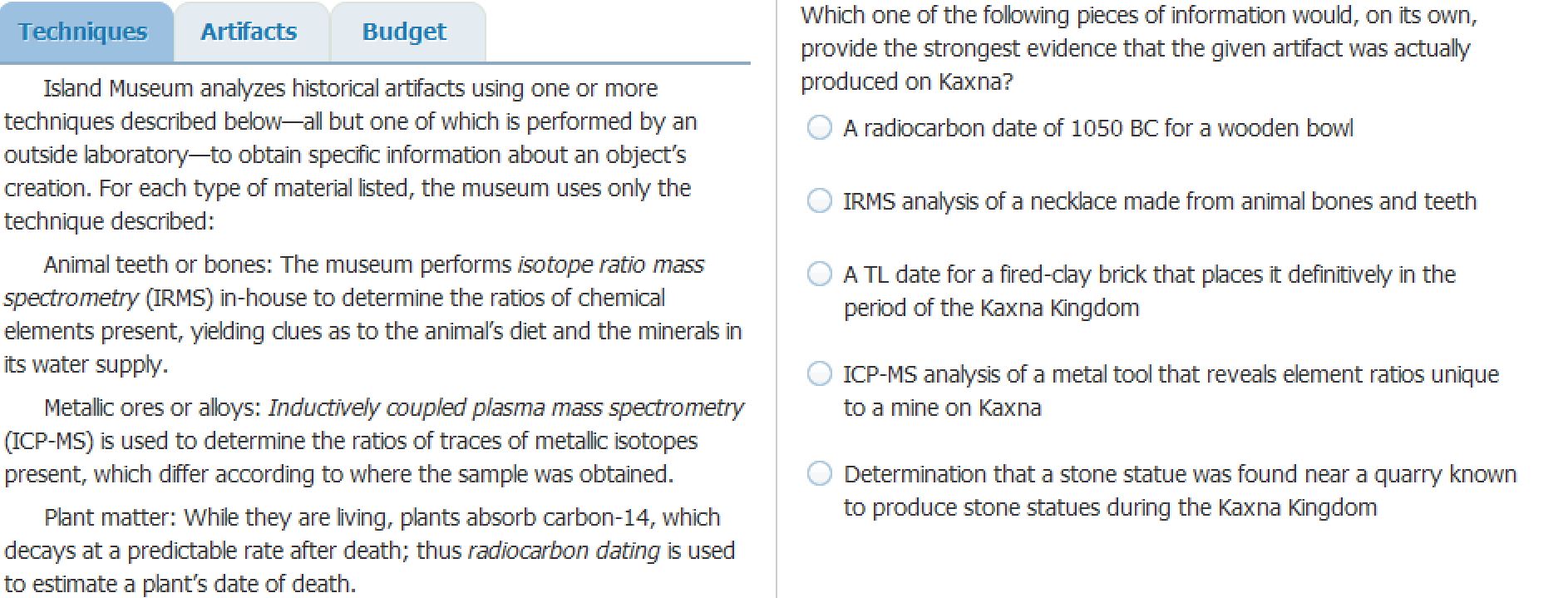
Information may include historical background, statistics, or charts. Note that in this example, you could find out more about ‘Techniques,’ ‘Artifacts,’ or ‘Budget.’ Clicking each tab will display a different set of information.
For these question types, remember that y ou will be asked more than one question about the same set of data.
In Multi-Source Reasoning, you are being tested not only on your ability to integrate different kinds of information, but also to discern which information is relevant to a given question. Choose wisely. Not all the tabs will be important for every question, and some questions will require you to refer to multiple tabs to synthesize information from different sources.
Want to Identify YOUR GMAT Strengths and Weaknesses?
Our proprietary GMAT Diagnostic Assessment creates a customized study plan for you that takes you from registration all the way to test day! It is included with every account and proven to significantly maximize your score .
Get your personalized assessment as part of your 5 day risk-free trial now:

Graphics Interpretation
Graphics Interpretation questions will require you to answer questions about a table, graph, or chart, like this one:
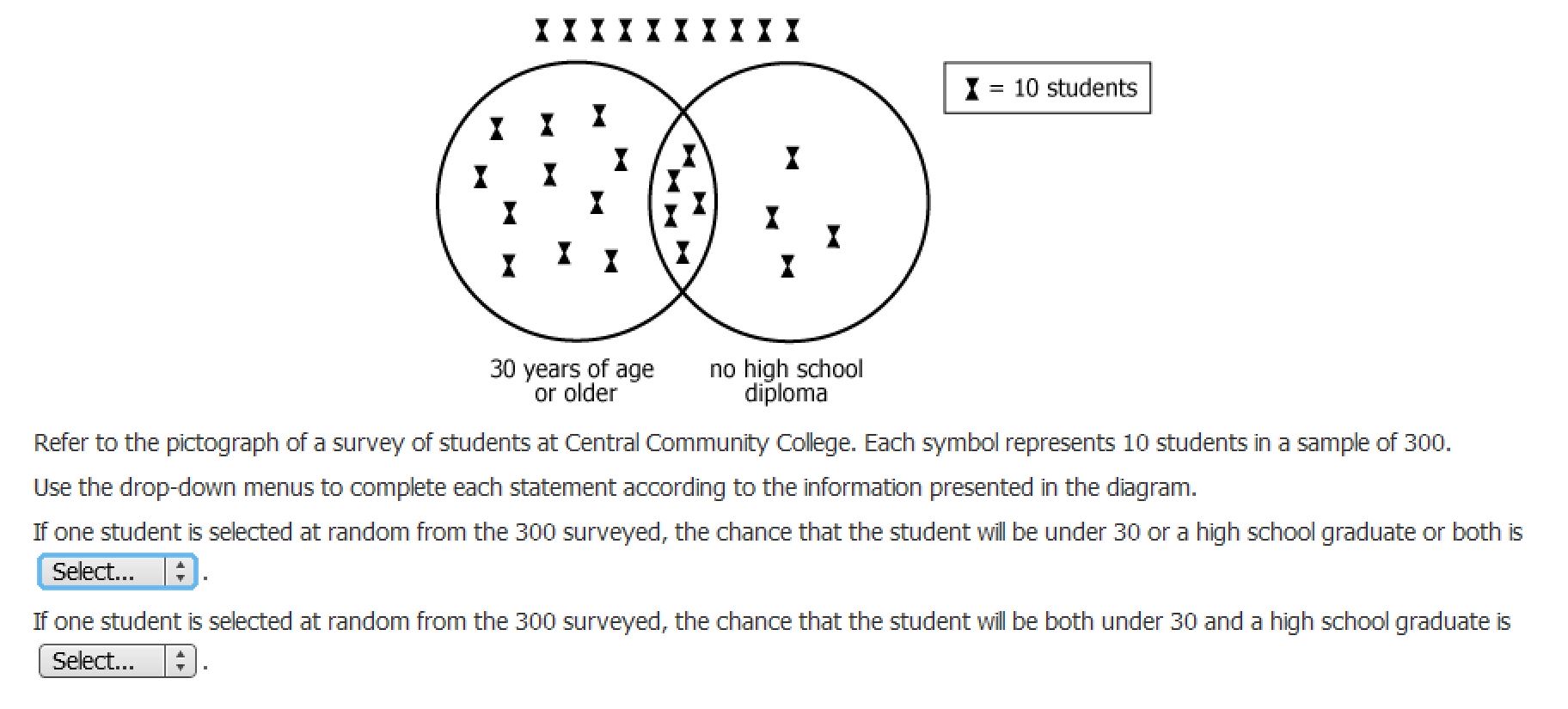
In these questions, you’ll see incomplete statements about the information presented in the graphic. You will use a drop down menu like the one above to make the statements complete and accurate. Choose an answer from each drop down menu. There is no partial credit if you choose only one of the drop-down items correctly.
Two-Part Analysis
Two-Part Analysis questions will ask you to read a passage and solve a two-part ‘word problem’ using two multiple-choice columns:
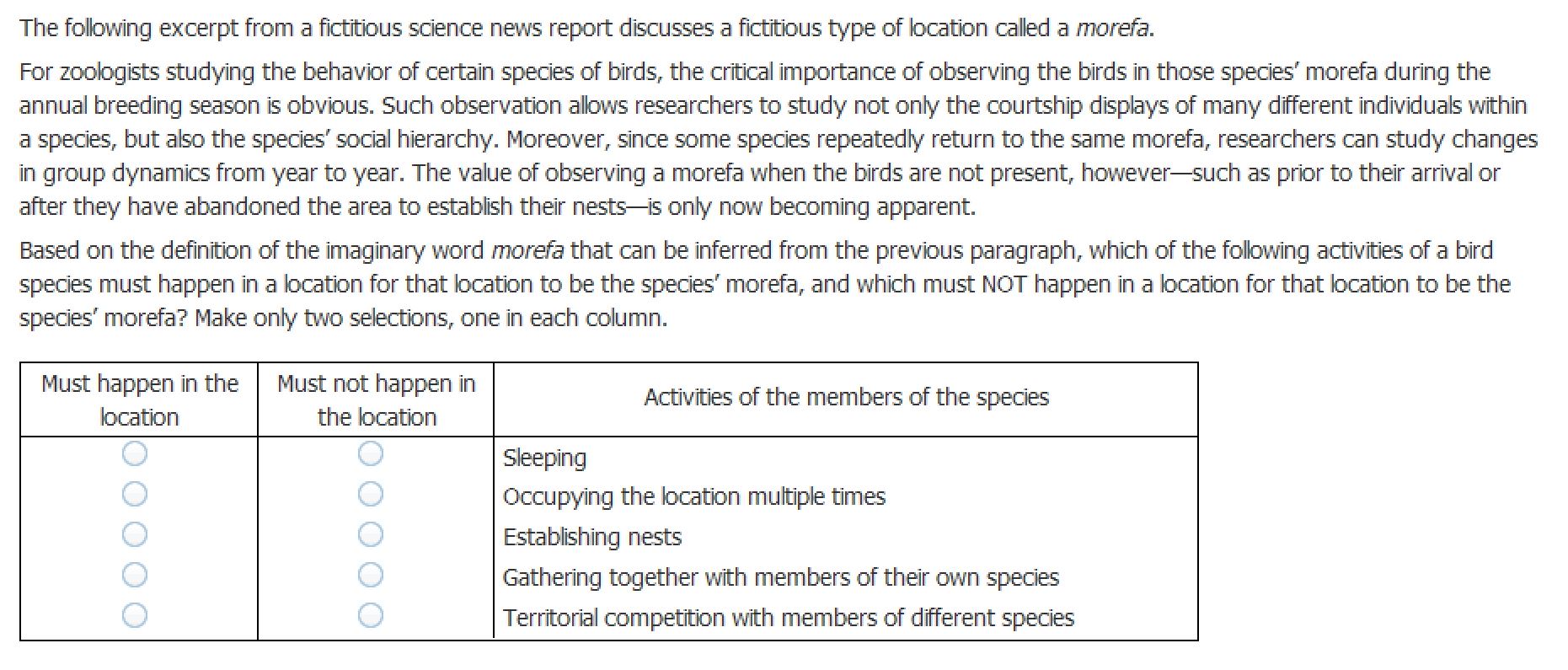
Here, you would choose one option from the ‘Must not happen in the location’ column and one option from the ‘Must happen in the location’ column.
Read two-part analysis questions carefully ; while they may appear simpler than the other question types, they often require you to make inferences based on subtle details in the passage.
Choose only one answer in each column. You cannot choose the same answer for each column. Both must be correct to receive credit.
Table Analysis
In Table Analysis questions, you’ll be asked questions based on tables with a variety of data, like this one:
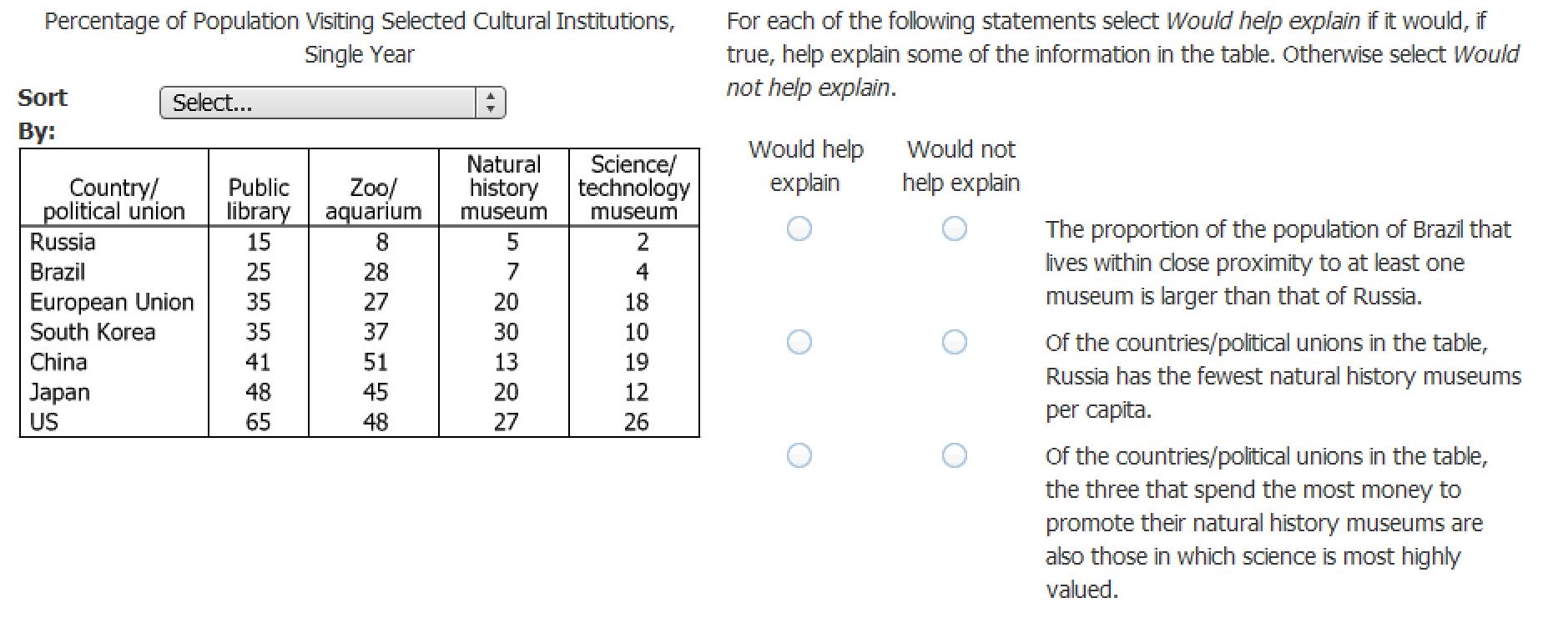
Each Table Analysis question will ask you if certain statements are True/False or Inferrable/Not Inferrable based on the information available in the table. Choose one answer for each statement.
All of your answers must be correct to get credit for a Table Analysis question. As in the rest of the IR section, there is no partial credit.
Take advantage of the ‘Sort By’ button. This button allows you to organize the table horizontally or vertically based on whatever piece of information you want to highlight. This is a great tool to give you a quick visual shorthand and will help you zero in on the relevant information for the question at hand.
On-Screen Calculator
An onscreen calculator with basic functions is provided for you in the IR section. You can access it by clicking “Calculator” on the upper lefthand corner of your screen.
The calculator will then appear in the center of your screen:
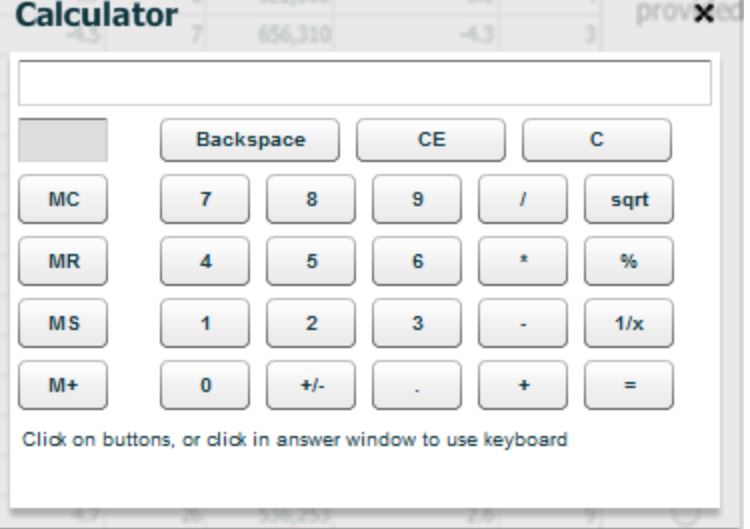
- MC, Memory Clear, which clears and resets the memory.
- MR, Memory Recall, which ‘remembers’ and displays whatever is in recent memory.
- M+, Memory Addition, which adds the current entry to the current stored memory.
- MS, Memory Store, which stores in the current memory whatever is displayed on the screen.
The top row has three buttons: Backspace, CE (Clear Entry), and C (Clear All).
The IR calculator doesn’t follow order of operations.
Tips for Succeeding on the Integrated Reasoning Section
- You must answer all parts of IR questions correctly to get credit for them. This can’t be reiterated enough. There is no partial credit for any IR question. If there’s a three-part question and you only get one part incorrect, the question as a whole is marked ‘wrong.’ So, if you’re trying to hurry, don’t guess on the last part of a question just to move on.
- Don’t be tempted to use the calculator too often. It may save you time for basic calculations, but you really don’t need to use it for most of the IR section. Integrated Reasoning doesn’t test your math skills; it tests your ability to make sound decisions and think logically, and you have to do so in quite a time crunch. Don’t let the calculator distract you.

The Quantitative (Quant) section of the GMAT test format is 62 minutes long and consists of 31 questions. This section tests your ability to use basic math and quantitative reasoning skills to draw conclusions from given data. There are two question types in the Quant section: Data Sufficiency and Problem Solving.
Data Sufficiency
Like the other sections of the GMAT, the Quant section contains a strong logic component. In that vein, Data Sufficiency questions ask you to consider an initial question and two statements, labeled (1) and (2), and decide whether the statements are sufficient to answer the question asked. Take a look at this example:
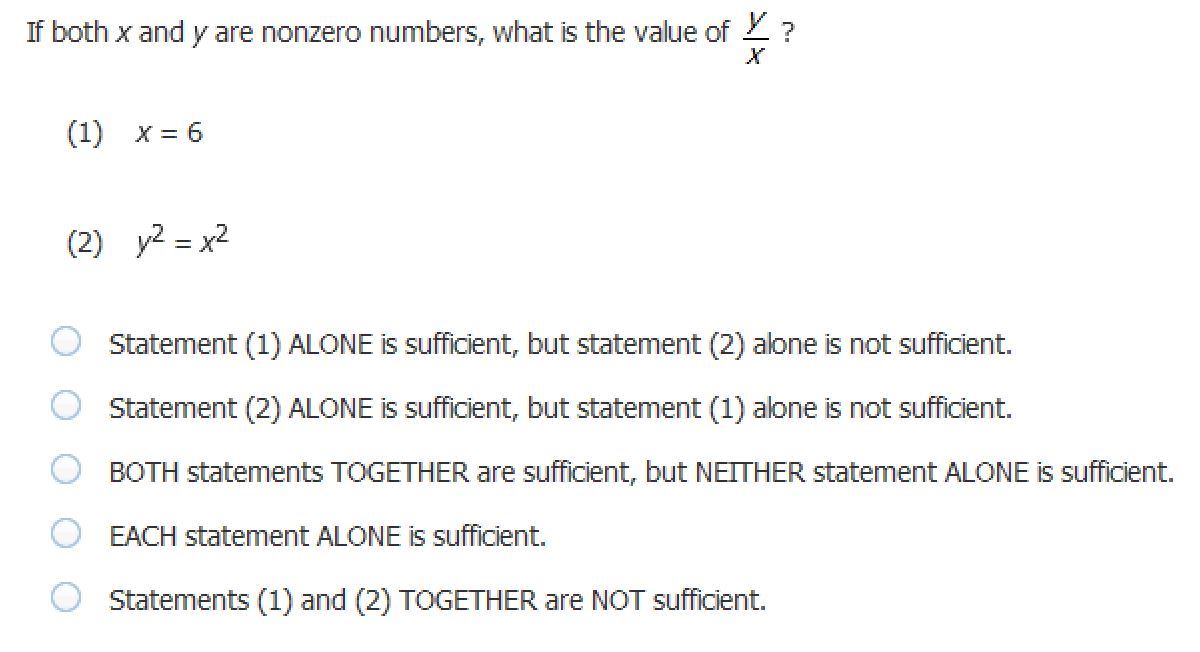
Note that the five choices listed under the question and two statements in this example will be the same for every Data Sufficiency question, so they’re easy to spot.
You should memorize the five Data Sufficiency answer choices before you take the GMAT. This will save you a great deal of time so you only have to consider the given question and two statements, instead of wrestling with the answer choices on top of those, too.
In this context, ‘sufficient’ means ‘I could answer this question fully with ONLY the information in this statement or these statements.’ That means, for example, that the first two choices ask you if, given each statement separately, you could answer the question correctly.
Problem Solving
Problem Solving questions will ask you to choose one multiple choice answer to complete an equation or solve a word problem. Here’s an example:
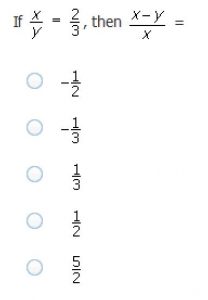
Problem Solving questions draw from basic knowledge (such as the number of days in a month) and common secondary-level education math skills. In contrast to Data Sufficiency questions, Problem Solving questions are similar to the kinds of questions you might see in the Quantitative section of the GRE, SAT, or ACT.
Tips for Succeeding on the Quantitative Section
- There is no calculator on the Quantitative section. Only the Integrated Reasoning section allows you access to a standard calculator. You can use your erasable notepad to do calculations, but if you review number properties in your preparation for the GMAT, you shouldn’t need to use it much.
- You have about two minutes for each question in the Quant section. Keep track of the time as you go along, and don’t spend too long on any one question.
- The Quant section draws from secondary level math skills like arithmetic, geometry, and algebra. They’re not overly difficult, but you may have forgotten some of the details. A review of these skills will be helpful to you in your exam preparation.

The GMAT Verbal Section takes 65 minutes and consists of 36 questions. The Verbal section tests your ability to read critically, to make sound inferences and draw accurate conclusions from those readings, and to correct errors in grammar and sentence structure. There are three question types in the Verbal section: Reading Comprehension, Critical Reasoning, and Sentence Correction.
Reading Comprehension
Reading Comprehension questions will present you with a brief passage and questions that ask you about its tone, main idea, details, or structure. Questions may also ask you to draw inferences from the information in the passage. Here’s a sample Reading Comprehension passage:
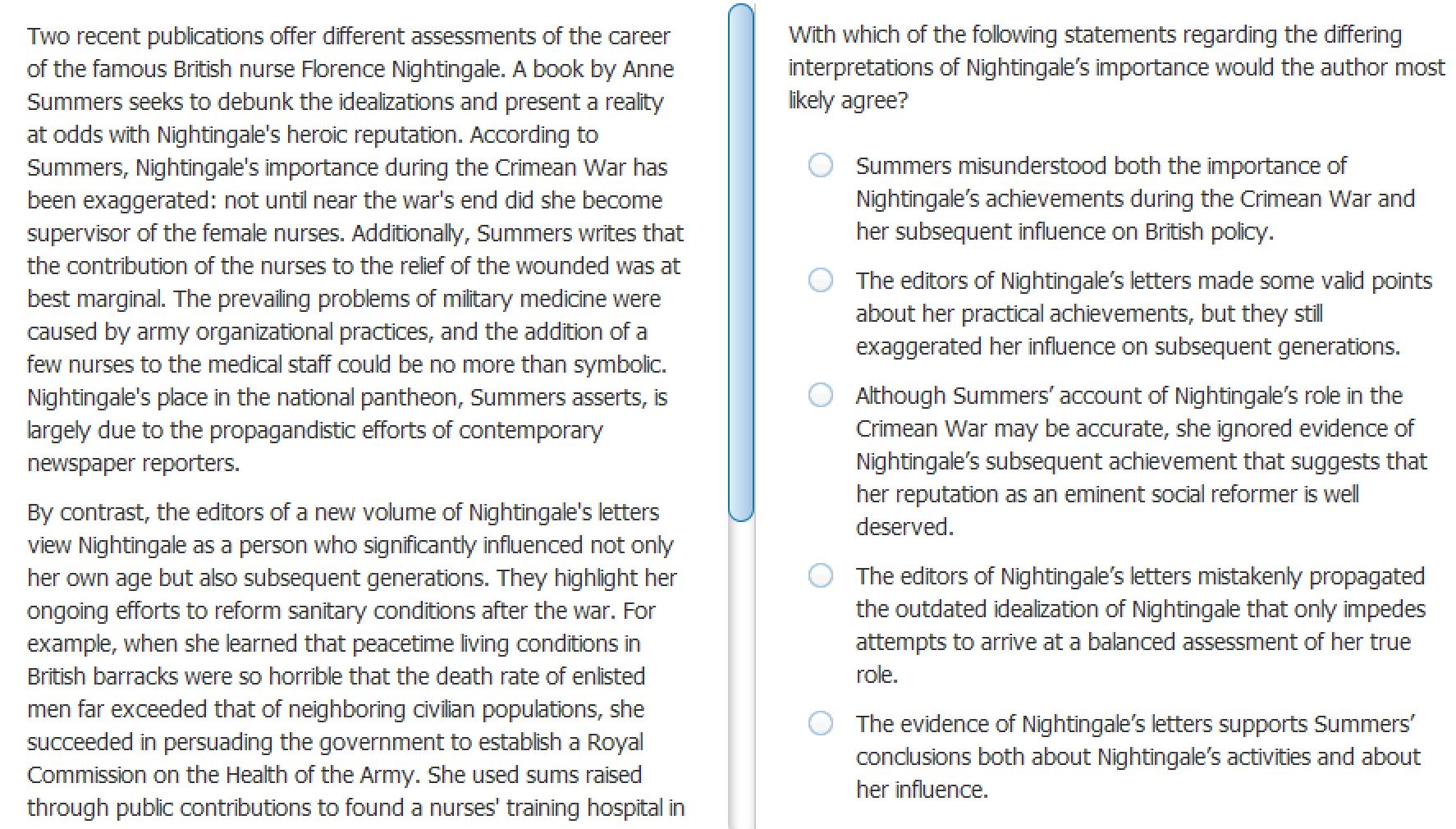
Reading Comprehension passages are always nonfiction; there is never a fiction/literature passage in the bunch. They might draw from humanities, business-related topics, or the natural or social sciences. However, the exact subject doesn’t that much since you don’t need any outside knowledge to be successful on Reading Comprehension questions.
Generally speaking, there will be one or two longer Reading Comprehension passages (around 350 words) and around three shorter passages (around 250 words). Each Reading Comprehension passage is accompanied by a series of several questions. You will be shown the same passage alongside each one (usually around four).
Critical Reasoning
Critical Reasoning questions ask you to evaluate, unpack (break down), or draw conclusions from a given argument or short passage, like this one:
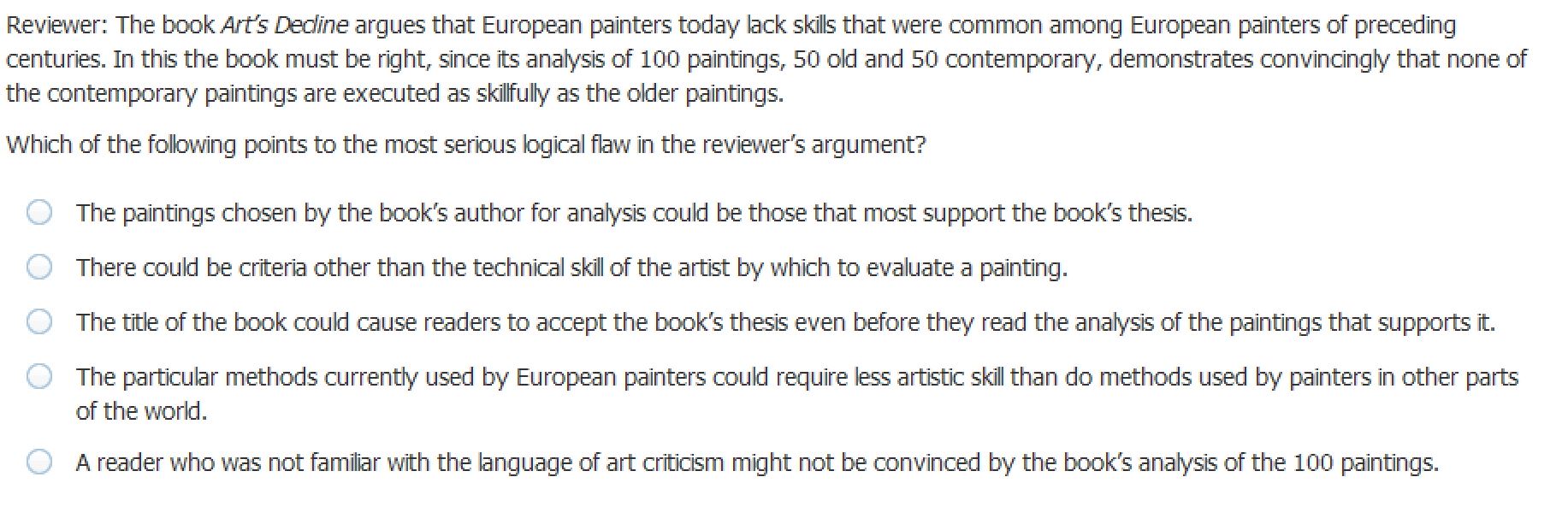
Pay close attention to what you’re being asked. Are you being asked to make an inference, for example, or to discern the main idea? Knowing will help you choose what to focus on and select a strategy.
Read each answer choice fully before you choose one of the five. There could be subtle missteps that you’ll overlook if you don’t read every answer choice.
Sentence Correction
Sentence Correction questions present a sentence with an underlined portion. Your job is to choose, out of five answer choices, the choice that would best replace the underlined portion of the given sentence:

As in this example, the first answer choice is always a direct repetition of the original underlined portion. The other four answer choices all differ from the original in some way.
In Sentence Correction, you’ll be tested on grammar concepts like punctuation, adjectives and adverbs, phrases and clauses, run-ons and fragments, dangling and misplaced modifiers, and the like. But if you don’t know what some of those are, it’s OK! You need to know about the concepts, not the terms.
Incorrect answers might be grammatically incorrect, redundant, ambiguous, illogical, or otherwise awkwardly written or ineffective. You won’t be tested on spelling.
Tips on Succeeding in the Verbal Section
- You have about a little over a minute and a half for each question in the Verbal Section. Move as quickly as you can without sacrificing accuracy.
- Every question type in the Verbal section requires only one multiple choice answer.
- Read each sentence all the way to the end, particularly in Sentence Correction questions. Sometimes an answer choice will seem fine at the start, but the ending is what’s incorrect. It can be tempting to skim, but if there’s one section where you don’t want to do this, it’s the Verbal section.

Whew! Now that we’ve gone through a breakdown of each section, you should have a much better idea of what the GMAT test format will look like onscreen. Familiarity with the question types is a great start on your road to GMAT prep. Here are some other ways to make the GMAT exam format work for you rather than overwhelm you:
- Take a simulated computerized adaptive test. For this kind of a test, doing practice questions on your own probably won’t be enough. Instead, you’ll want to be more familiar with test day conditions so you feel more relaxed the day of the test. You can simulate the real GMAT exam format using the free GMATPrep software, offered by the Graduate Management Admissions Council (GMAC) to everyone with an account at mba.com (also free). You can find it here.
- Familiarize yourself with the format of each section and question type. Recognizing each question type quickly will empower you to approach each question with more confidence and a more effective strategy.
- Don’t be afraid of guessing. There are no penalties for incorrect answers on the GMAT, so don’t be afraid to take a guess and move on to the next question if you’re taking too long. However, if you prepare sufficiently, you will almost always be able to eliminate one or more of the answer choices, which increases your chances of getting the question correct.
- You should always take the optional breaks on exam day. This will refresh your mind and help you mentally ‘reset’ before the next section.
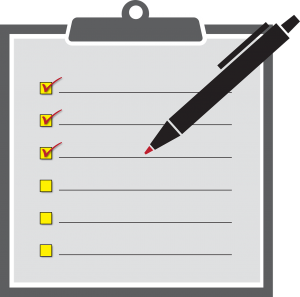
In this article, we’ve covered the GMAT structure and format, some logistics for test day, the fundamentals of computerized adaptive testing, and a few tips on how to make the most of the GMAT test format. Let’s recap some of the main takeaways:
- There are four sections of the GMAT: Analytical Writing Assessment, Integrated Reasoning, Quantitative, and Verbal. Each one has a different set of question types. You’ll encounter the same question types in each section no matter when you take the test or how well you do on each question.
- You can choose the order in which you want to take the GMAT sections.
- The GMAT is a computerized adaptive test, which means that the test adapts to your skill level as you go along in order to compute your score.
- But on test day, you shouldn’t worry about figuring out whether each question is difficult or easy. Instead, you should focus on answering every question to the best of your abilities.
- Reread this article whenever you need to and take an official computerized test to make sure you’re fully prepared for the GMAT exam format. Familiarity is power!

What’s Next?
Ready to sign up for the GMAT? Read our step-by-step guide on how to register for the GMAT .
Worried about the GMAT section will be too difficult for you? We break down how hard the GMAT actually is .
Curious about how to prepare? Check out our sample GMAT study schedules and tips on building your own prep plan.
Was this helpful? Sign up for FREE GMAT and MBA guides!
Share this:.
- Click to share on Twitter (Opens in new window)
- Click to share on Facebook (Opens in new window)
- Click to share on Google+ (Opens in new window)
Author: Laura Dorwart
Laura Dorwart is a Ph.D. student at UC San Diego. She has taught and tutored hundreds of students in standardized testing, literature, and writing. View all posts by Laura Dorwart
Ultimate Guide to Writing Your College Essay
Tips for writing an effective college essay.
College admissions essays are an important part of your college application and gives you the chance to show colleges and universities your character and experiences. This guide will give you tips to write an effective college essay.
Want free help with your college essay?
UPchieve connects you with knowledgeable and friendly college advisors—online, 24/7, and completely free. Get 1:1 help brainstorming topics, outlining your essay, revising a draft, or editing grammar.
Writing a strong college admissions essay
Learn about the elements of a solid admissions essay.
Avoiding common admissions essay mistakes
Learn some of the most common mistakes made on college essays
Brainstorming tips for your college essay
Stuck on what to write your college essay about? Here are some exercises to help you get started.
How formal should the tone of your college essay be?
Learn how formal your college essay should be and get tips on how to bring out your natural voice.
Taking your college essay to the next level
Hear an admissions expert discuss the appropriate level of depth necessary in your college essay.
Student Stories
Student Story: Admissions essay about a formative experience
Get the perspective of a current college student on how he approached the admissions essay.
Student Story: Admissions essay about personal identity
Get the perspective of a current college student on how she approached the admissions essay.
Student Story: Admissions essay about community impact
Student story: admissions essay about a past mistake, how to write a college application essay, tips for writing an effective application essay, sample college essay 1 with feedback, sample college essay 2 with feedback.
This content is licensed by Khan Academy and is available for free at www.khanacademy.org.
- E-mail & Password
- Notification Settings
- Global Settings
- Applicant profile
- Update status
- My GMAT info
- --> My Education -->